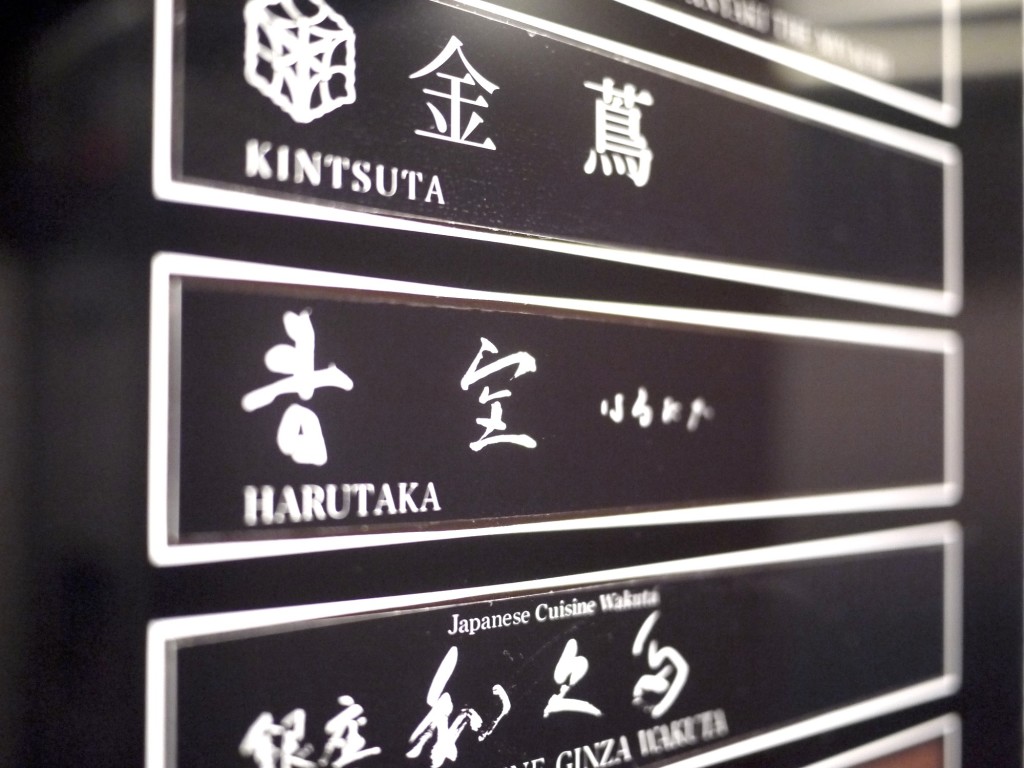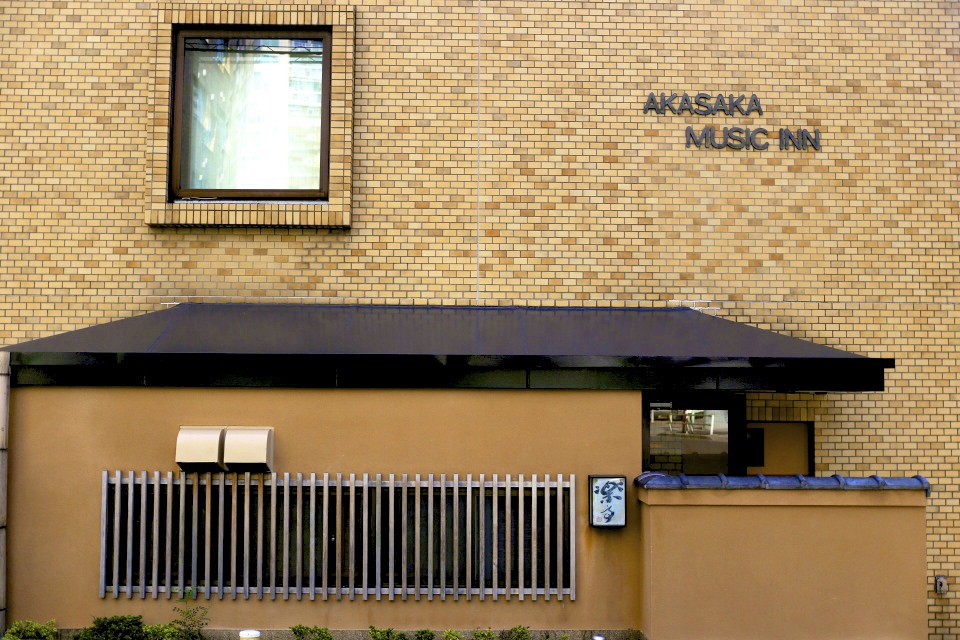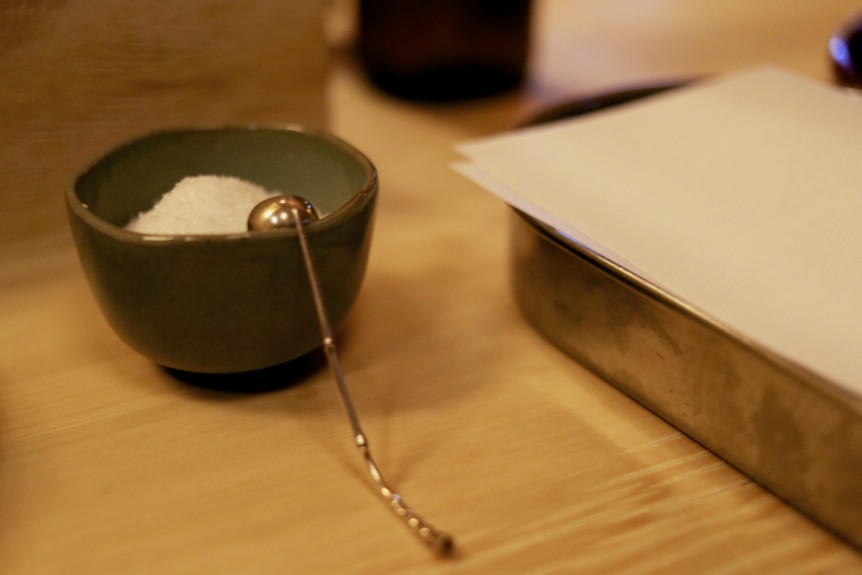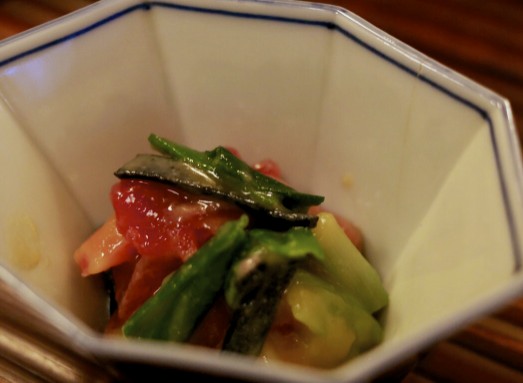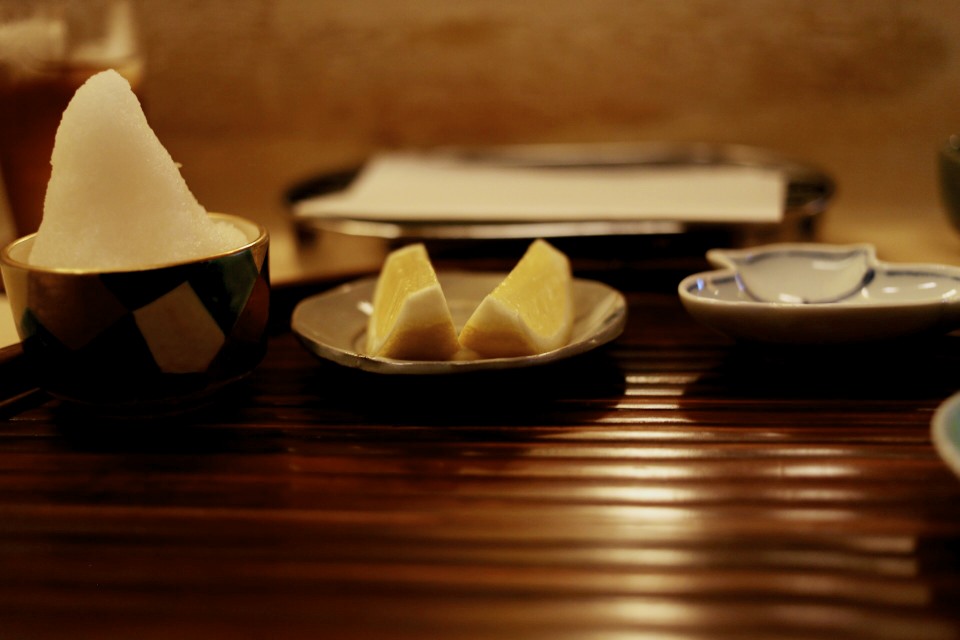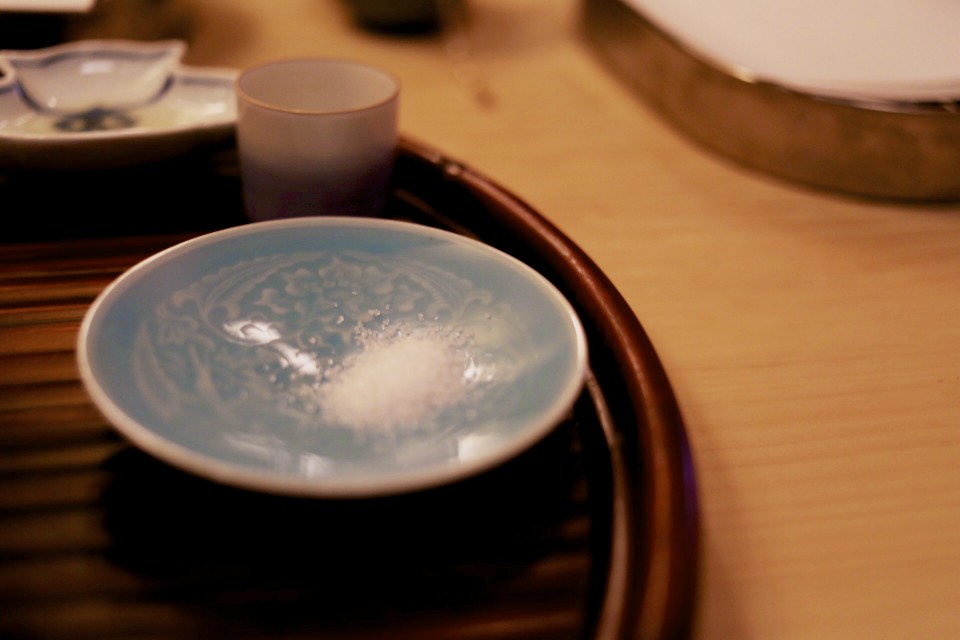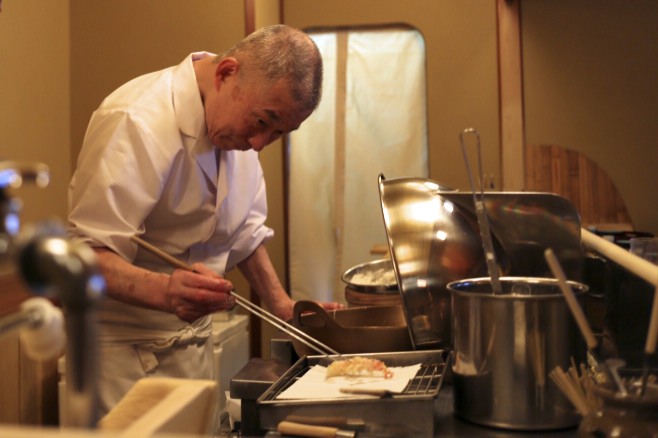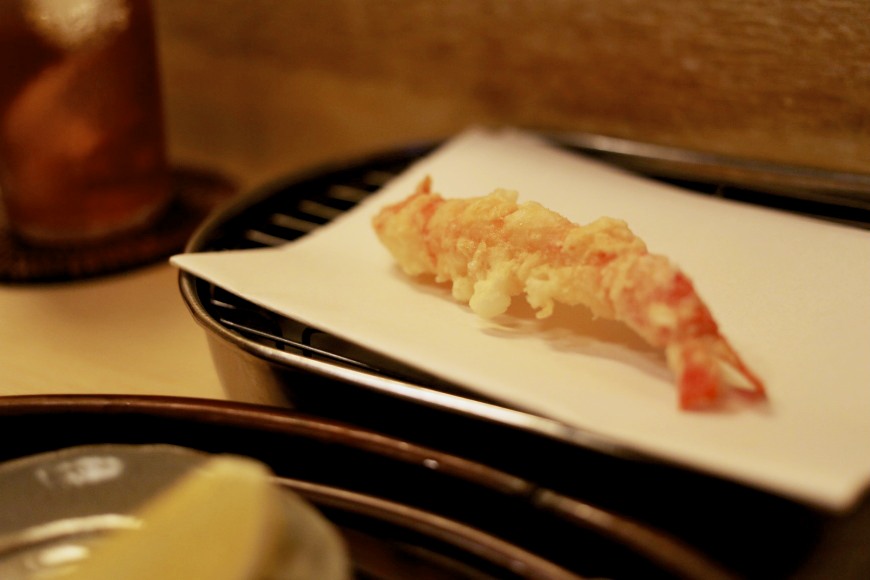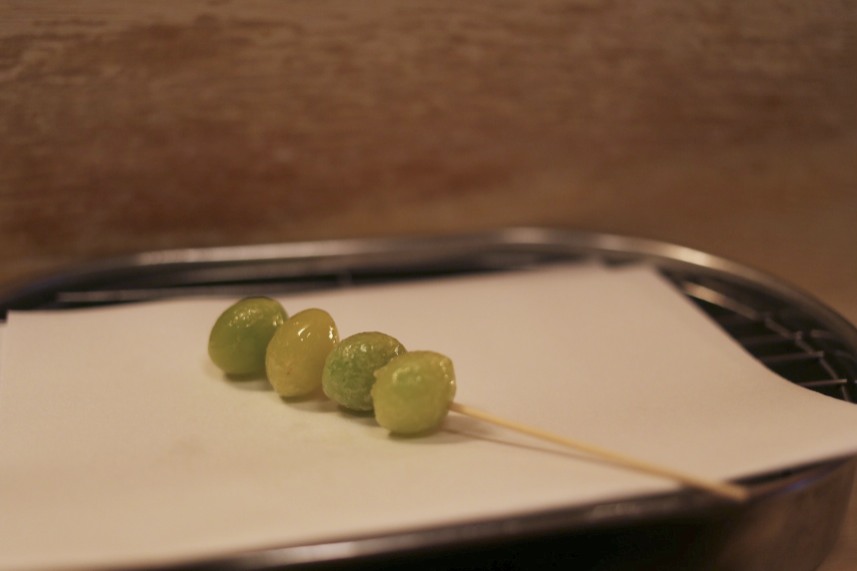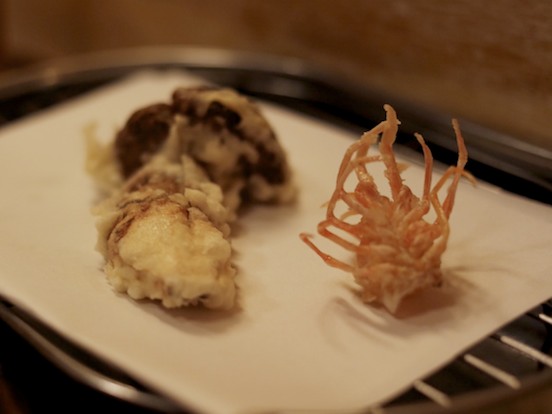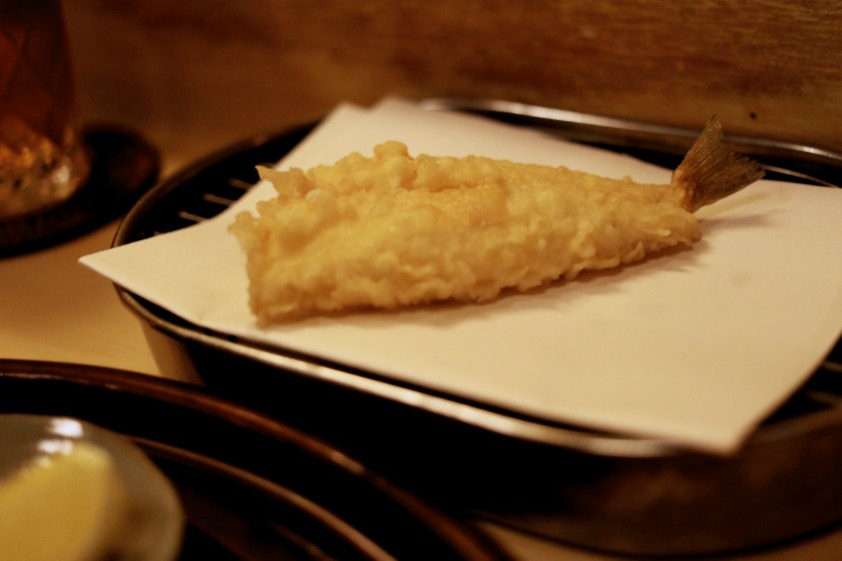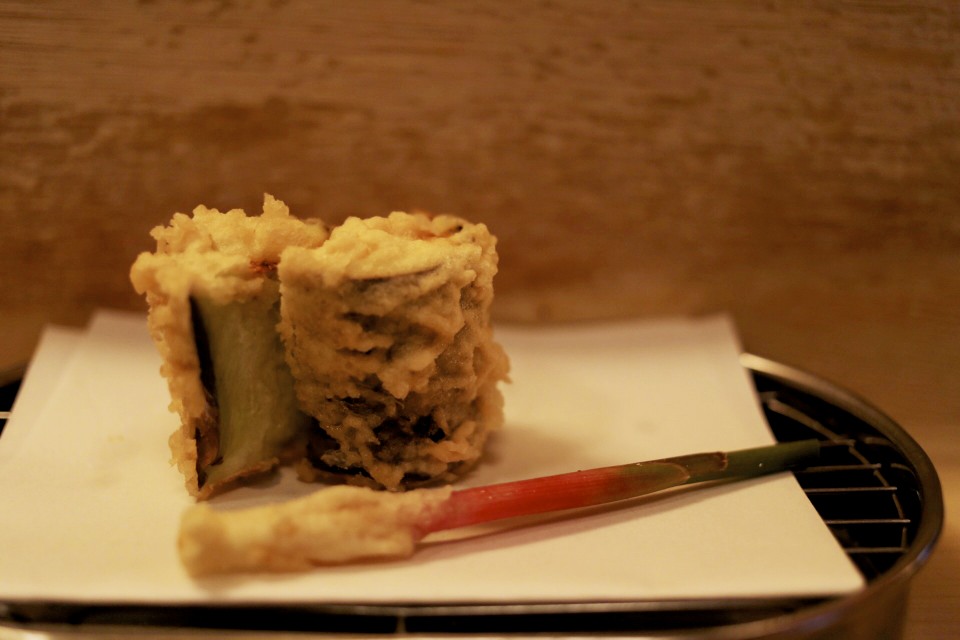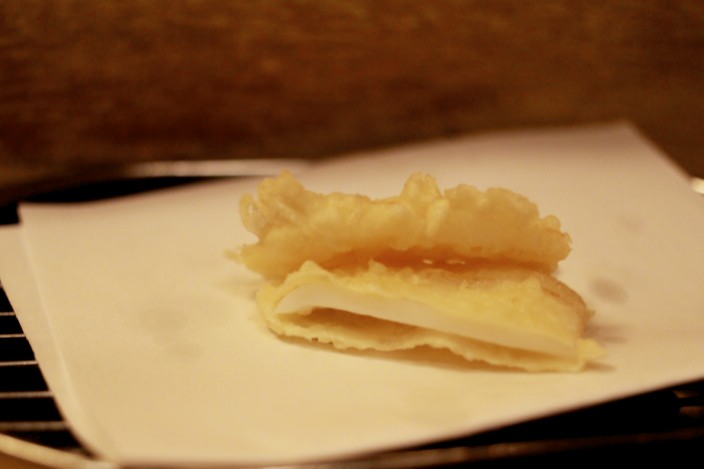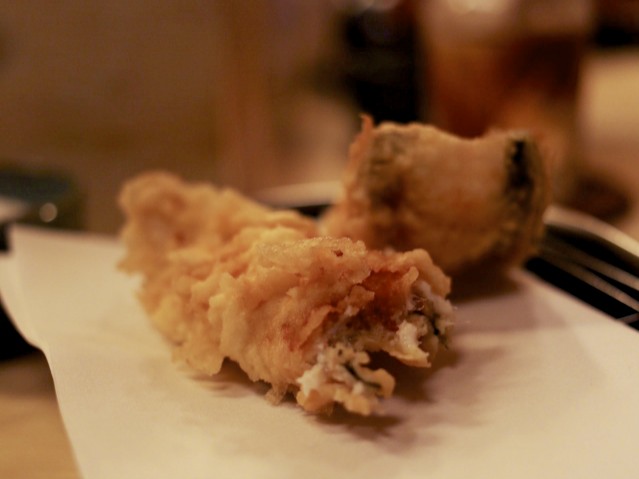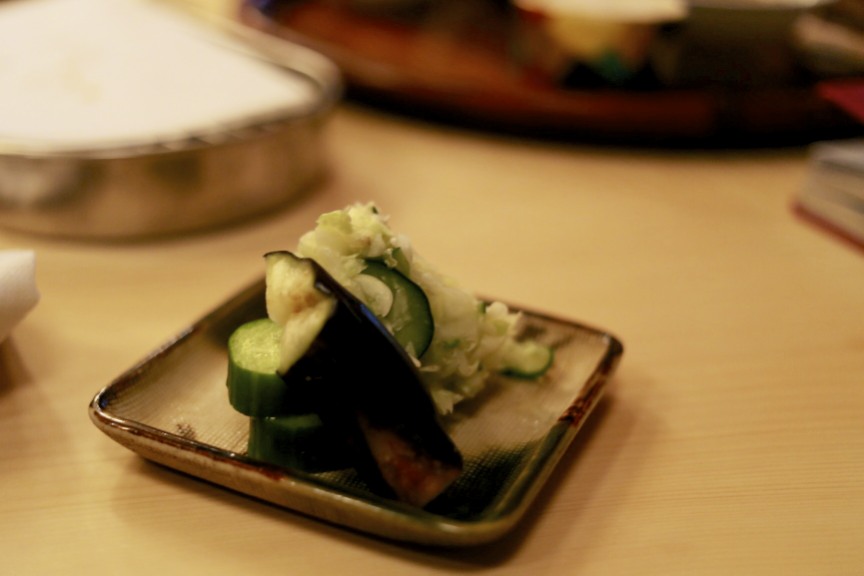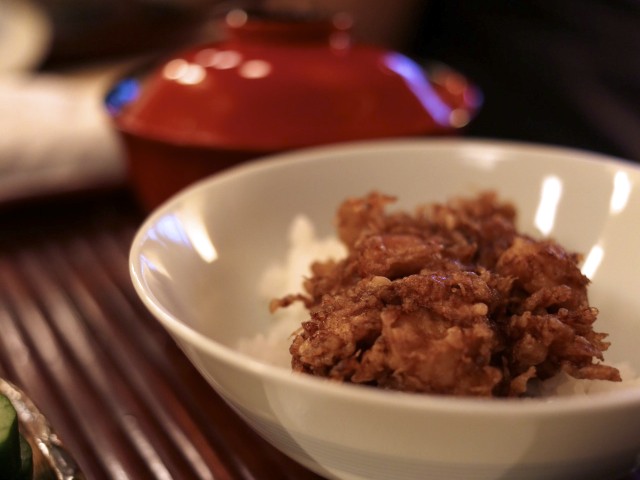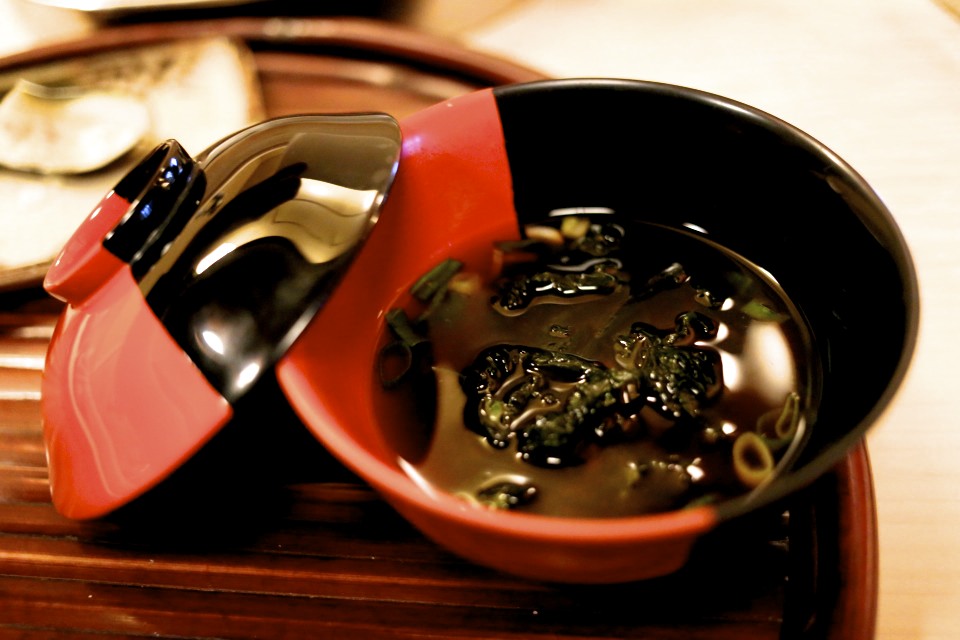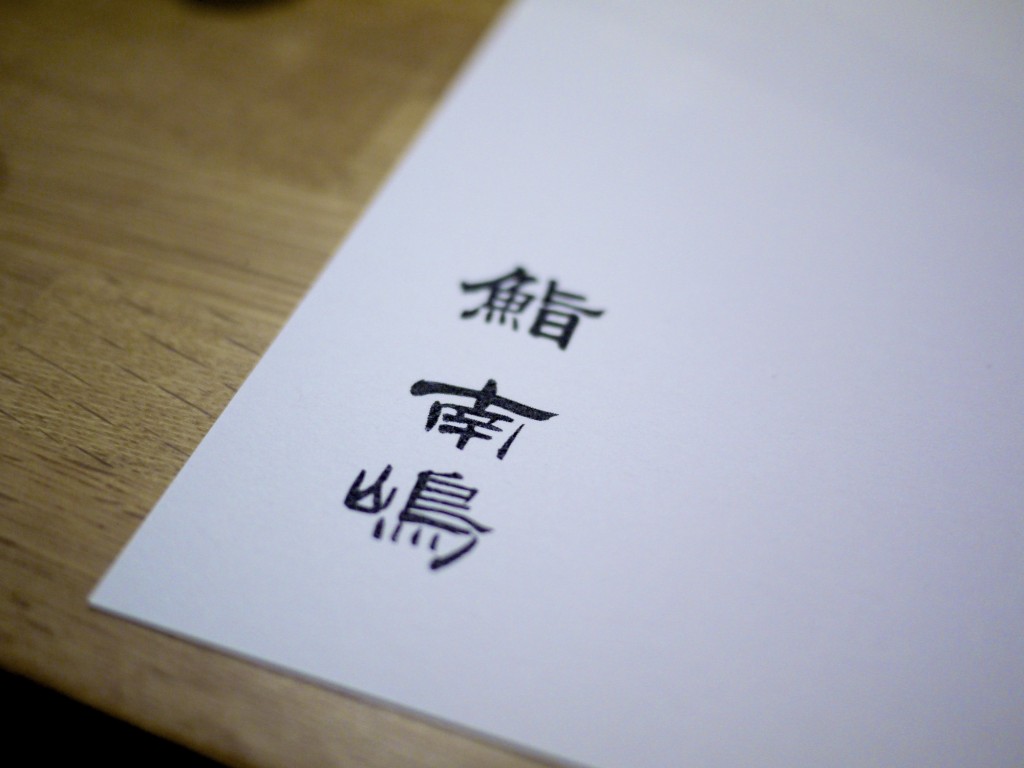 Chef: Koichi Minamishima Website: www.minamishima.com.au Cuisine: Edomae sushi
Chef: Koichi Minamishima Website: www.minamishima.com.au Cuisine: Edomae sushi
One of my greatest disappointment in Australia to date has been the poor quality of authentic Japanese cuisine, particularly in Melbourne. Sure, Sydney has a handful of old school institutions like Juju but when it came to the matter of sushi, Australia has a lot of catching up to do. I was therefore very excited when I heard about a place in Richmond, Melbourne that opened up in 2014 and had attained two hats almost immediately. It specialised in edomae sushi. This, I thought, was the answer to my prayers…
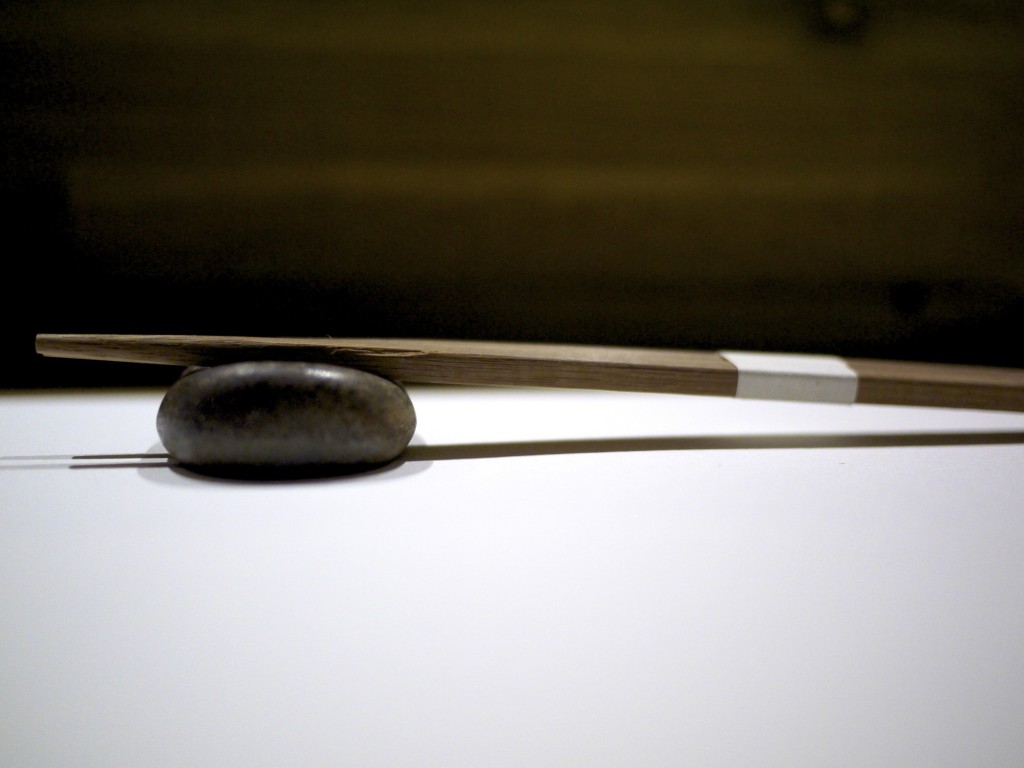 Unlike many overseas sushi restaurants that have been opened up by successful chefs from Tokyo, Minamishima is headed up by chef Koichi Minamishima who spent his formative years at Kenzan, Melbourne. This was a sticking point for me as Kenzan had not impressed me in the past. More importantly it wasn’t known for sushi. However, I had heard good things so I decided to keep an open mind.
Unlike many overseas sushi restaurants that have been opened up by successful chefs from Tokyo, Minamishima is headed up by chef Koichi Minamishima who spent his formative years at Kenzan, Melbourne. This was a sticking point for me as Kenzan had not impressed me in the past. More importantly it wasn’t known for sushi. However, I had heard good things so I decided to keep an open mind.
There’s only one menu at Minamishima which both makes it easy for the undecided and ensures the best seasonal fish is utilised for all customers. AUD $150 buys you a 15 course meal which can be complimented with matching sake or wine. There were also three additional courses offered that evening, two starters and a dessert, for an additional cost…..which cumulatively matched the price of the 15 course menu.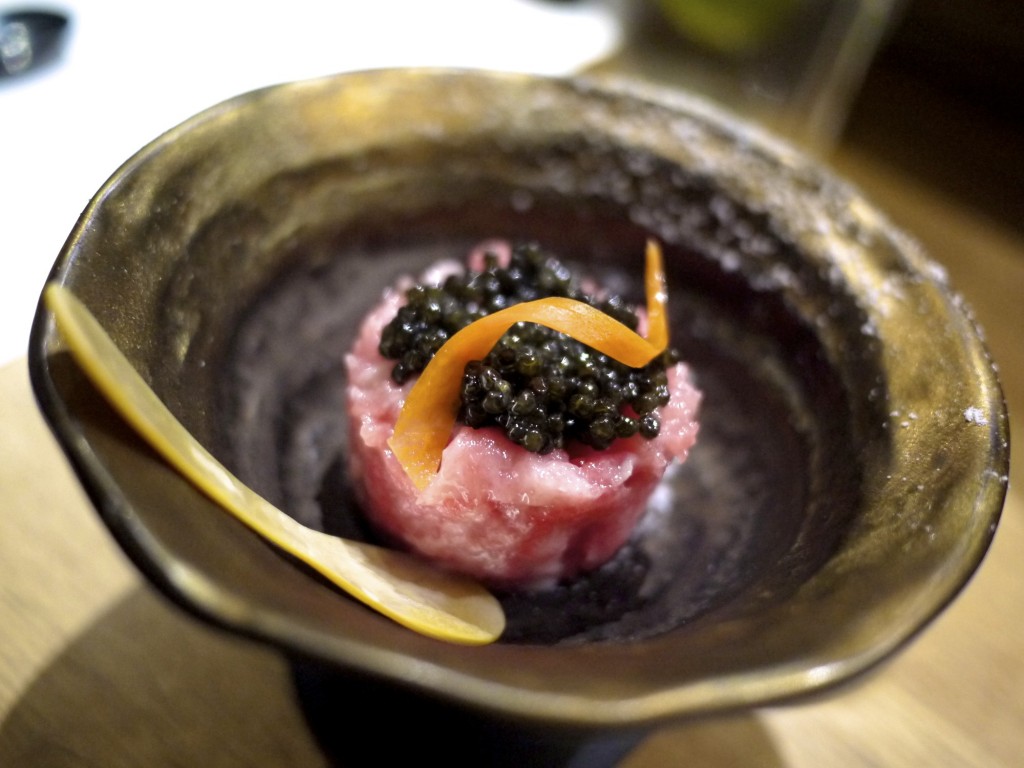 1st Course – Ootoro with Italian beluga black caviar (supplementary course at extra cost): It wasn’t cheap but was definitely worth every cent. The tuna was sourced that same week from Tsukiji market in Tokyo. The fatty ootoro (tuna belly) and the salty black caviar went ever so well together. The mother pearl shell spoon was obviously a must when eating black caviar for the purists.
1st Course – Ootoro with Italian beluga black caviar (supplementary course at extra cost): It wasn’t cheap but was definitely worth every cent. The tuna was sourced that same week from Tsukiji market in Tokyo. The fatty ootoro (tuna belly) and the salty black caviar went ever so well together. The mother pearl shell spoon was obviously a must when eating black caviar for the purists.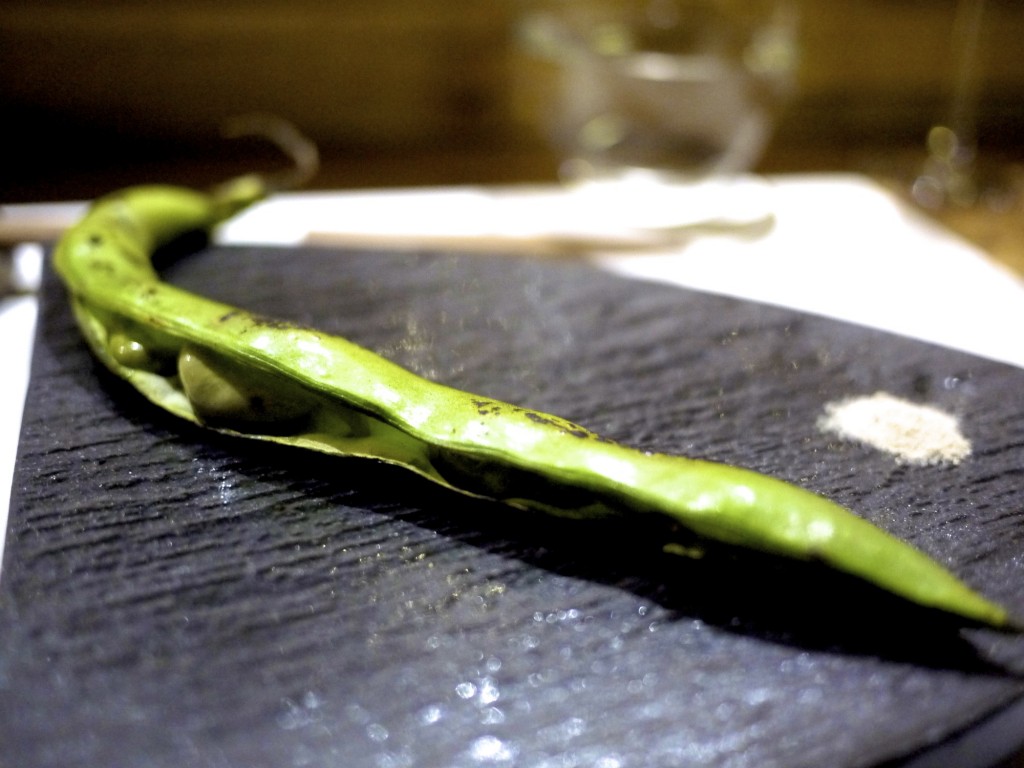 2nd Course – Grilled broad beans with shiitake salt: Not too dissimilar to edamame and I liked the earthy salt in combination with the beans.
2nd Course – Grilled broad beans with shiitake salt: Not too dissimilar to edamame and I liked the earthy salt in combination with the beans.
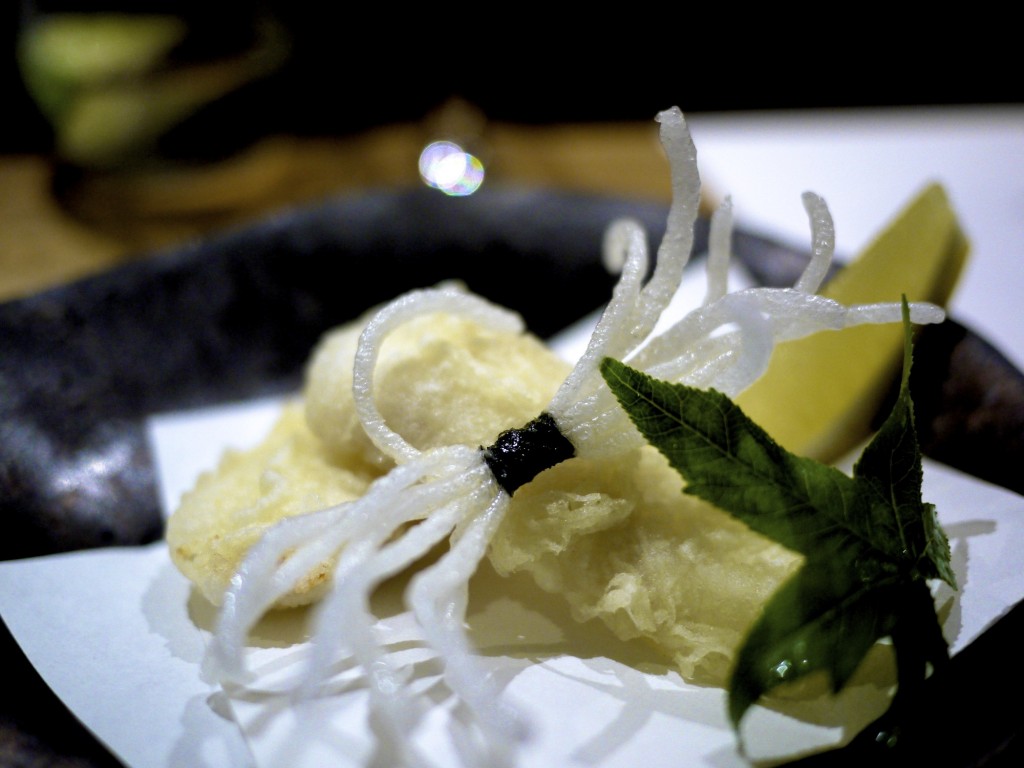 3rd Course – Fugu tempura (Supplementary course at extra cost): Minamishima-san explained that the fugu had been professionally prepared in Japan by a qualified professional before it was delivered to him in Melbourne. Much like most fugu’s I’ve previously tried, the flavour was very subtle and delicate. The tempura was surprisingly of good quality, not oily and quite crispy.
3rd Course – Fugu tempura (Supplementary course at extra cost): Minamishima-san explained that the fugu had been professionally prepared in Japan by a qualified professional before it was delivered to him in Melbourne. Much like most fugu’s I’ve previously tried, the flavour was very subtle and delicate. The tempura was surprisingly of good quality, not oily and quite crispy.
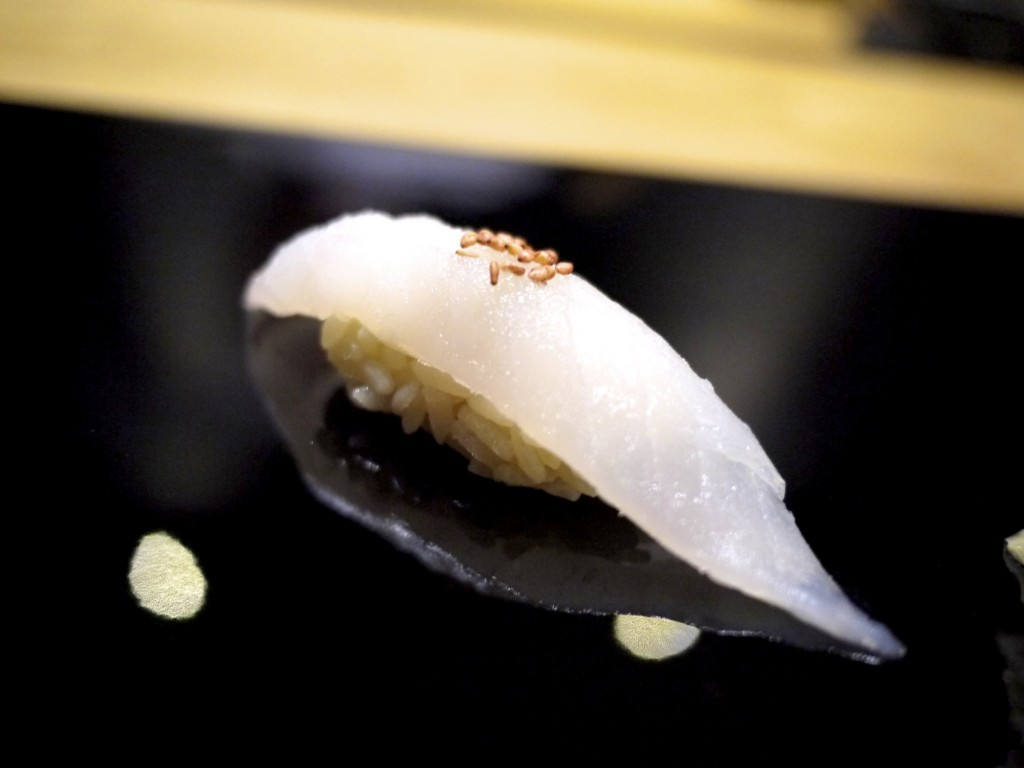 4th Course – King Dory: Cured king dory, a native fish only found in the southern Australian coast, New Zealand and South Africa with no Japanese name. A pinch of sesame and a squirt of lime blew some life into this thin slice of white meat.
4th Course – King Dory: Cured king dory, a native fish only found in the southern Australian coast, New Zealand and South Africa with no Japanese name. A pinch of sesame and a squirt of lime blew some life into this thin slice of white meat.
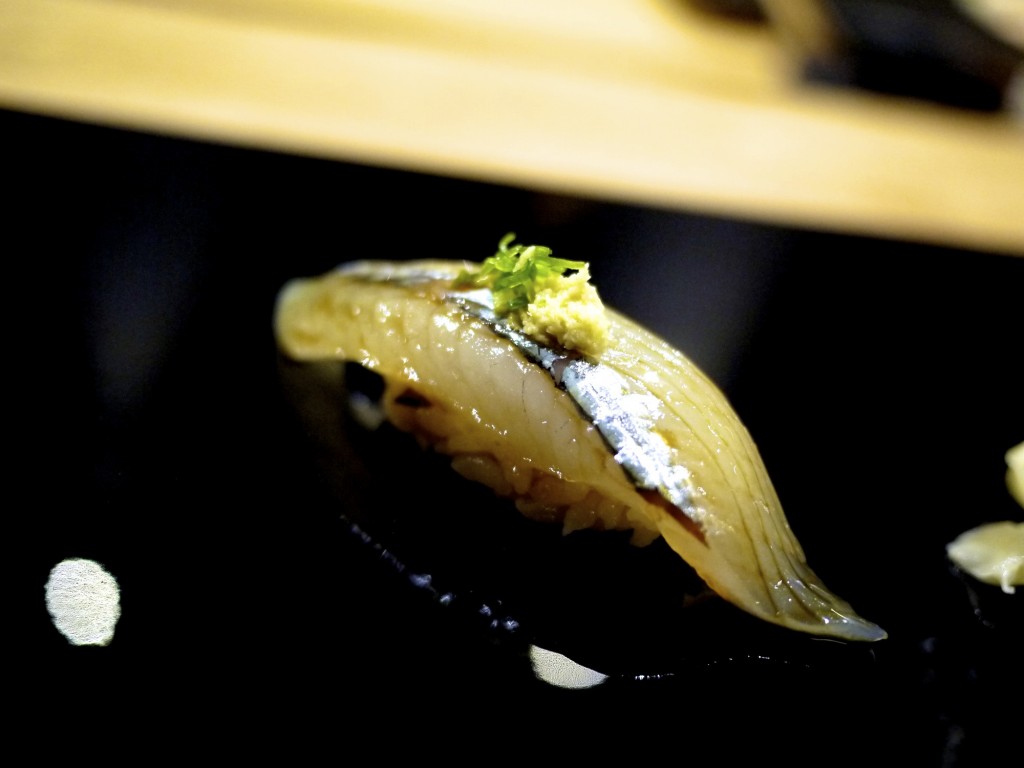 5th Course – Garfish / Sayori (サヨリ): Topped with thinly chopped spring onion and ginger, and some shiso hiding underneath the fish. The fish had been dressed with Minamishima’s home made soy sauce. Another delicate fish with a jelly like texture.
5th Course – Garfish / Sayori (サヨリ): Topped with thinly chopped spring onion and ginger, and some shiso hiding underneath the fish. The fish had been dressed with Minamishima’s home made soy sauce. Another delicate fish with a jelly like texture.
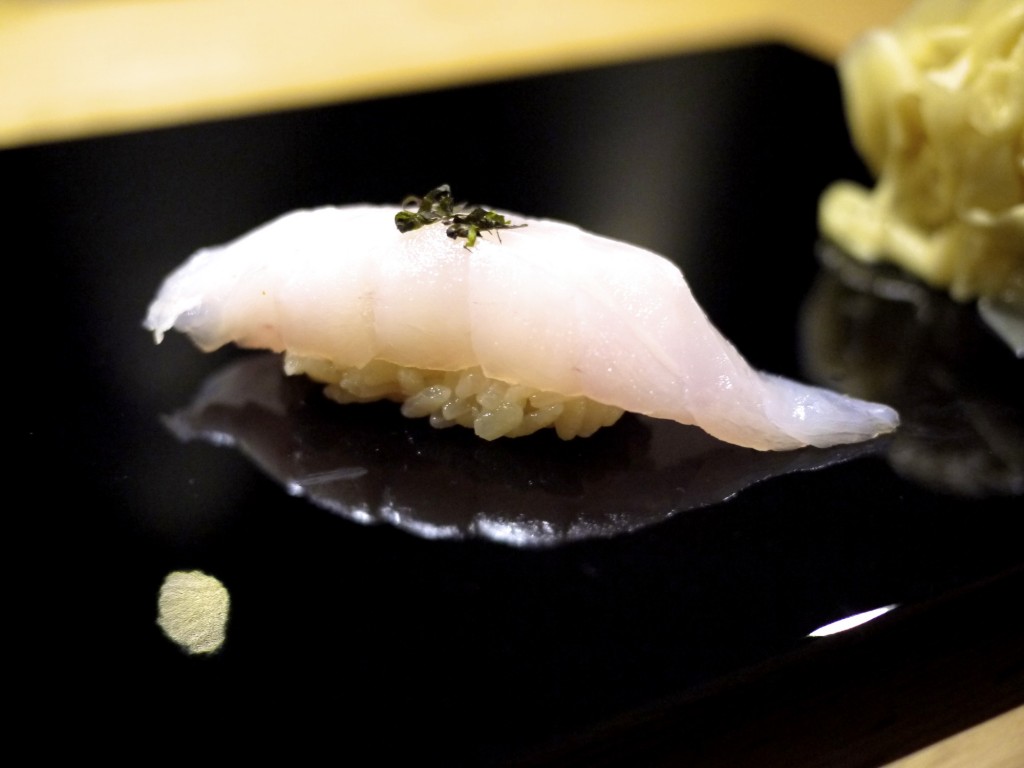 6th Course – Cod fish / Tara (鱈): Topped with shiso. My least favourite nigiri of the evening with unfortunately very little flavour.
6th Course – Cod fish / Tara (鱈): Topped with shiso. My least favourite nigiri of the evening with unfortunately very little flavour.
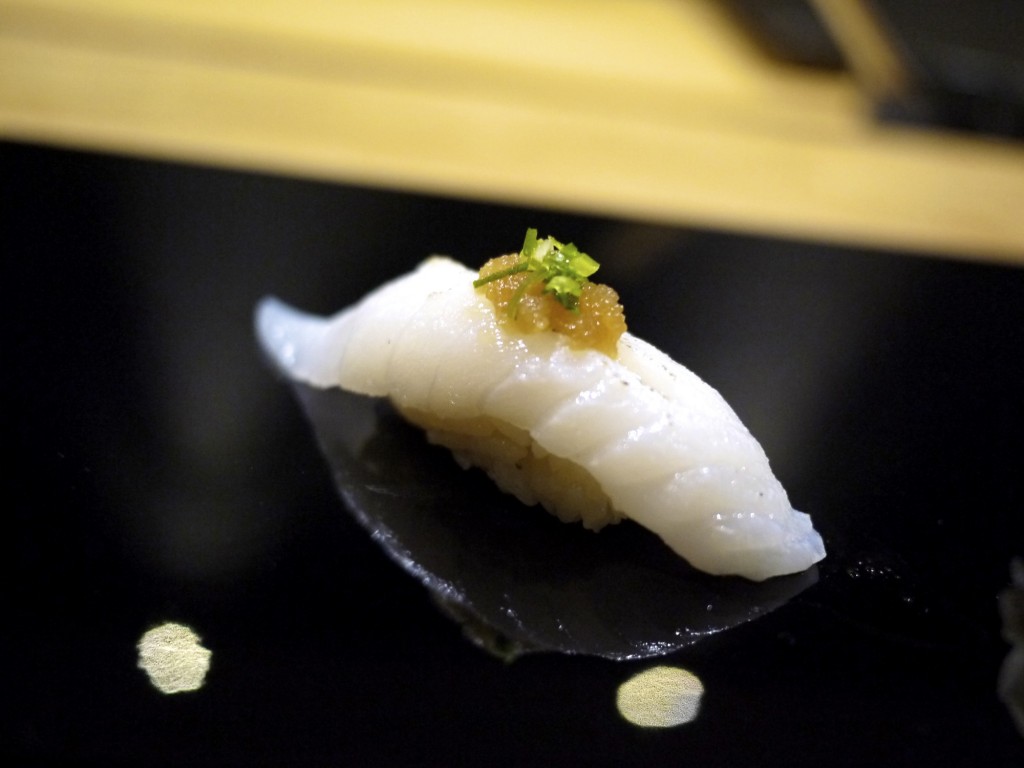 7th Course – Sea Perch / Suzuki (鱸): Finally on to a decent piece of sushi. This was what I was hoping to encounter! Great meaty texture and fattiness. The classic combination of ponzu and grated daikon (Japanese radish) with the sea perch worked well. Here’s to hoping there were plenty more like this ahead!
7th Course – Sea Perch / Suzuki (鱸): Finally on to a decent piece of sushi. This was what I was hoping to encounter! Great meaty texture and fattiness. The classic combination of ponzu and grated daikon (Japanese radish) with the sea perch worked well. Here’s to hoping there were plenty more like this ahead!
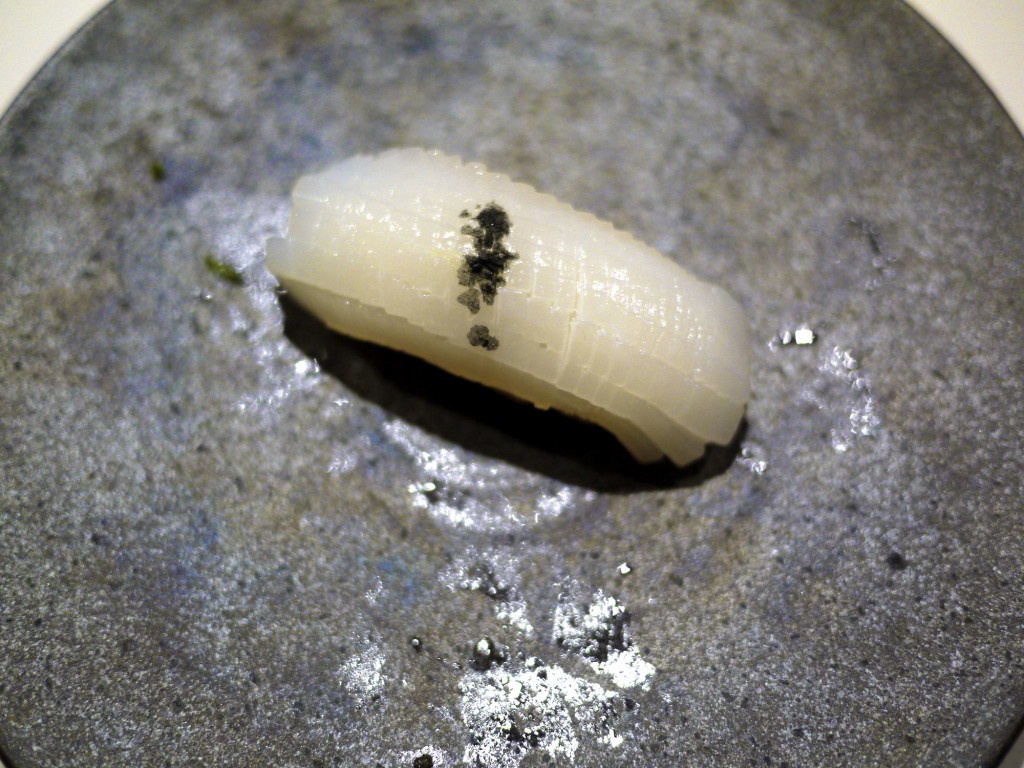 9th Course – Calamari / Aori Ika (アオリイカ): Served with sea salt and shiso leaves. A decent nigiri but not the best calamari I’ve had by a long shot. It had a beautiful creamy texture but I found the flavour rather bland.
9th Course – Calamari / Aori Ika (アオリイカ): Served with sea salt and shiso leaves. A decent nigiri but not the best calamari I’ve had by a long shot. It had a beautiful creamy texture but I found the flavour rather bland.
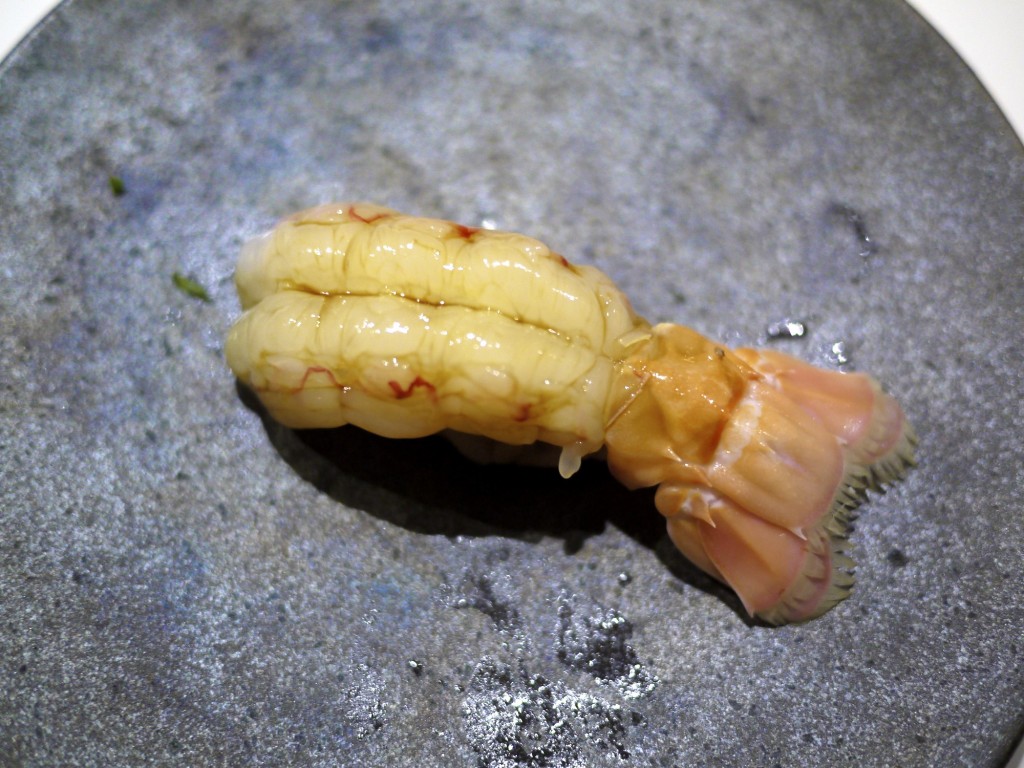 10th Course – Scampi / Tenaga Ebi (手長蝦): The scampi was sourced from New Zealand and was sweet, juicy and slightly crunchy. However, it’s definitely no contender to the classic superior choice of the kuruma-ebi which has a far more inviting aroma.
10th Course – Scampi / Tenaga Ebi (手長蝦): The scampi was sourced from New Zealand and was sweet, juicy and slightly crunchy. However, it’s definitely no contender to the classic superior choice of the kuruma-ebi which has a far more inviting aroma.
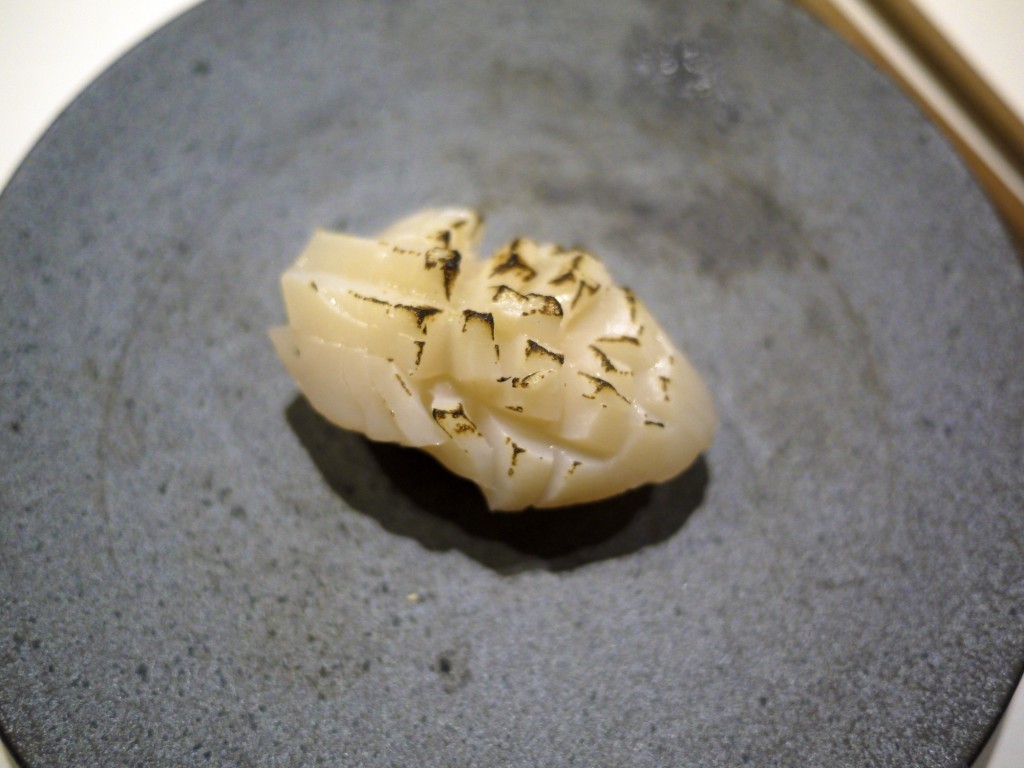 11th Course – Scallop / Hotate (帆立): The scallop, sourced from Hokkaido was, in my view, not treated with respect. The charring left a slight burnt aftertaste and ruined the soft and creamy texture that scallops are renown for. I did however like the smoky component and think this dish could be refined to a lighter degree of charring to make it perfect.
11th Course – Scallop / Hotate (帆立): The scallop, sourced from Hokkaido was, in my view, not treated with respect. The charring left a slight burnt aftertaste and ruined the soft and creamy texture that scallops are renown for. I did however like the smoky component and think this dish could be refined to a lighter degree of charring to make it perfect.
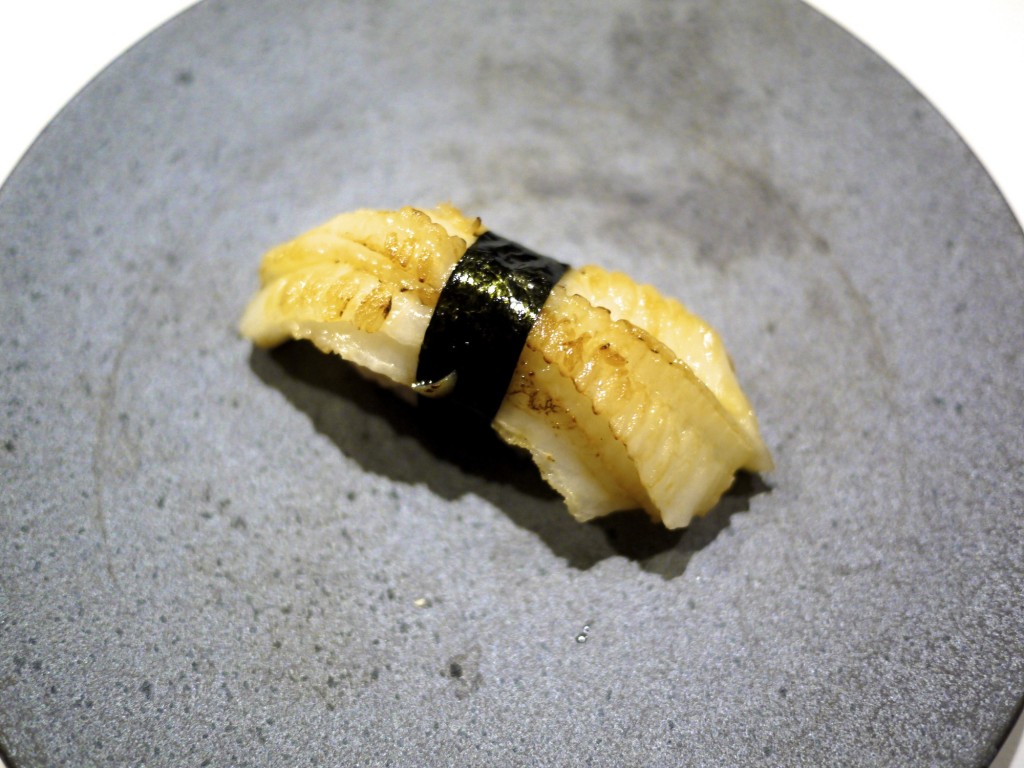 12th Course – Flounder / Karei (カレイ): Finally what I was waiting for. Something to blow me away! This was definitely my favourite dish of the entire evening and my god what a nigiri that was! The chef utilised the fin of the flounder from Hokkaido which is normally discarded. He then proceeded by intricately scoring it, lightly searing with a blowtorch and wrapping it with nori. The smell was ever so inviting and looked delicately beautiful. It packed a punch of rich, smoky, oily flavour, and a meltingly soft texture from the natural fat of the fish.
12th Course – Flounder / Karei (カレイ): Finally what I was waiting for. Something to blow me away! This was definitely my favourite dish of the entire evening and my god what a nigiri that was! The chef utilised the fin of the flounder from Hokkaido which is normally discarded. He then proceeded by intricately scoring it, lightly searing with a blowtorch and wrapping it with nori. The smell was ever so inviting and looked delicately beautiful. It packed a punch of rich, smoky, oily flavour, and a meltingly soft texture from the natural fat of the fish.
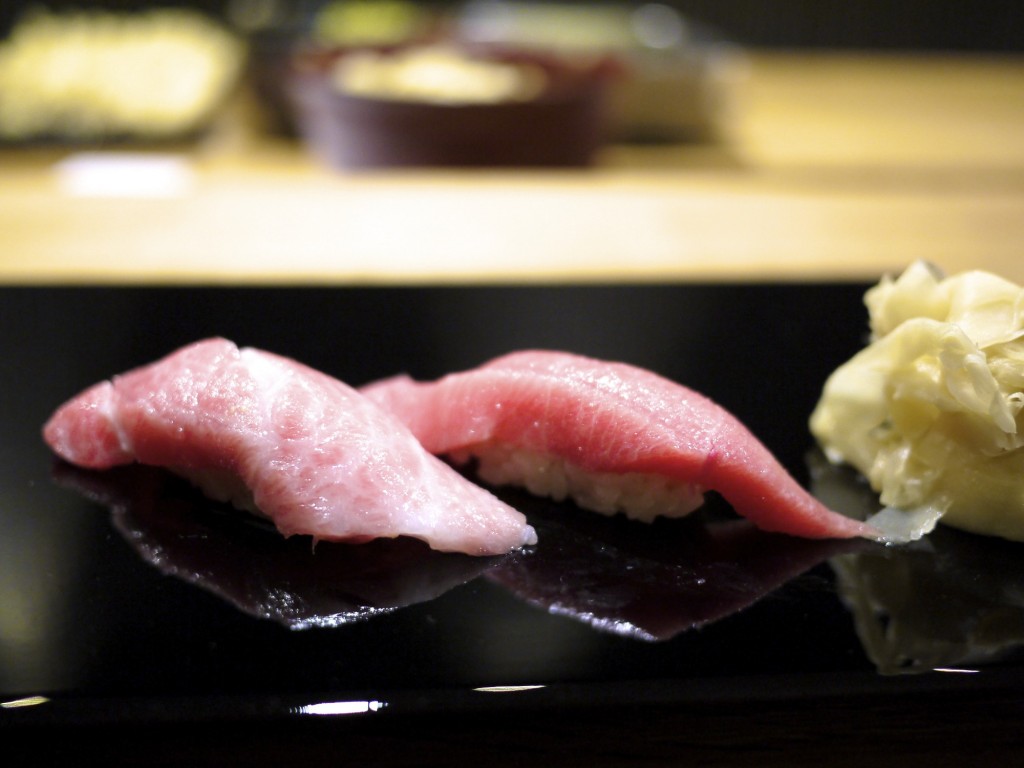 13th and 14th Course – Chutoro (中とろ) and Otoro (大とろ): The blue fin tuna (hon-maguro) was sourced again from Tsukiji. The quality was decent but I was amazed to find quite a bit of sinew in the ootoro. This was a cardinal sin and disappointing. The chutoro was, however, delightful.
13th and 14th Course – Chutoro (中とろ) and Otoro (大とろ): The blue fin tuna (hon-maguro) was sourced again from Tsukiji. The quality was decent but I was amazed to find quite a bit of sinew in the ootoro. This was a cardinal sin and disappointing. The chutoro was, however, delightful.
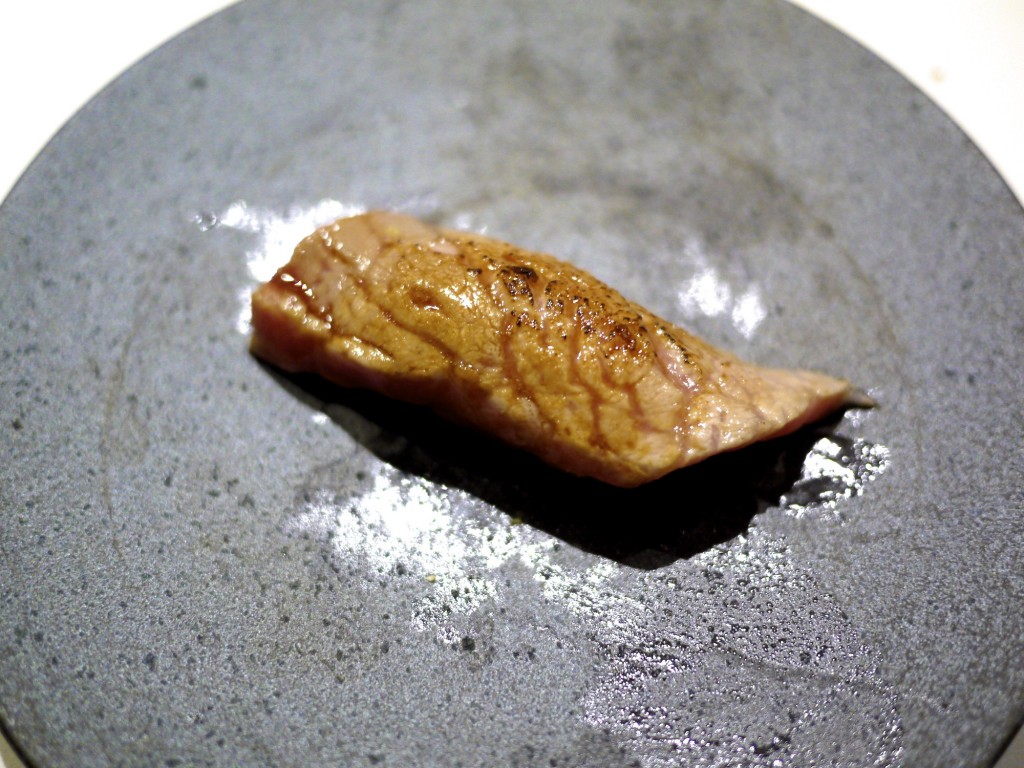 15th Course – Seared Ootoro / Aburi Ootoro (炙り大とろ): Whilst I would normally prefer my ootoro untouched and served as it is, this was far more enjoyable than the previous course as any remaining sinew fortunately had melted to create a juicy and fatty slice of ootoro.
15th Course – Seared Ootoro / Aburi Ootoro (炙り大とろ): Whilst I would normally prefer my ootoro untouched and served as it is, this was far more enjoyable than the previous course as any remaining sinew fortunately had melted to create a juicy and fatty slice of ootoro.
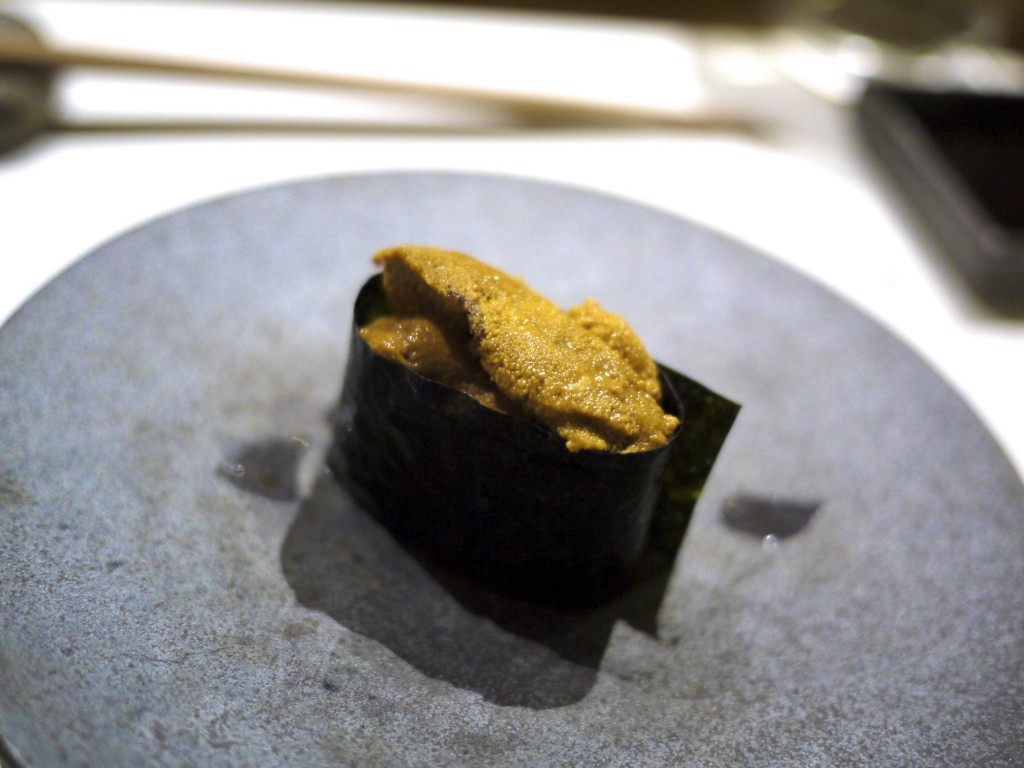 16th Course – Sea Urchin / Uni (ウニ): Sea urchin sourced from Tasmania. Lovely creaminess and absent of myoban and its bitter aftertaste, which is typically used to preserve the freshness of uni for those that are imported from overseas like Hokkaido. The flavour however was not as bold and distinct as the fresh ones you get in Japan.
16th Course – Sea Urchin / Uni (ウニ): Sea urchin sourced from Tasmania. Lovely creaminess and absent of myoban and its bitter aftertaste, which is typically used to preserve the freshness of uni for those that are imported from overseas like Hokkaido. The flavour however was not as bold and distinct as the fresh ones you get in Japan.
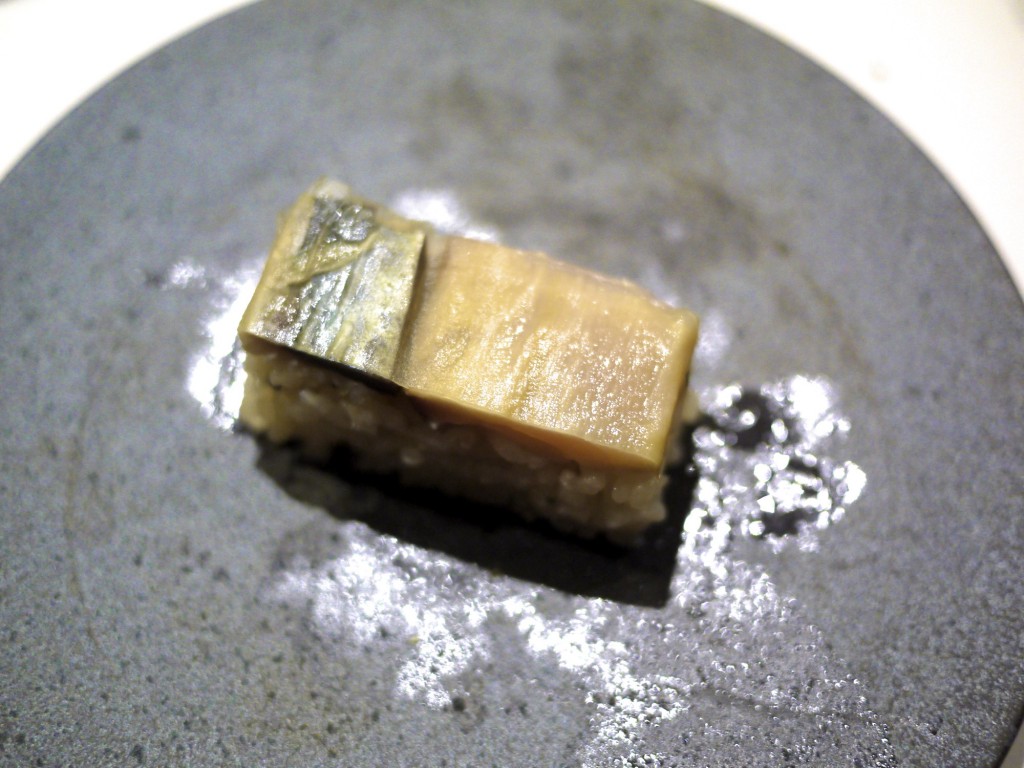 17th Course – Mackerel pressed sushi / Saba Oshizushi (さばの押し寿司): Also known as battera (バッテラ), this is one of my all time favourite sushi that I always order if available. The mackerel was cured well allowing the meat to retain its shape. The rice was infused with the lovely oily flavour of the fish and balanced against the sharpness of the vinegar from the curing process.
17th Course – Mackerel pressed sushi / Saba Oshizushi (さばの押し寿司): Also known as battera (バッテラ), this is one of my all time favourite sushi that I always order if available. The mackerel was cured well allowing the meat to retain its shape. The rice was infused with the lovely oily flavour of the fish and balanced against the sharpness of the vinegar from the curing process.
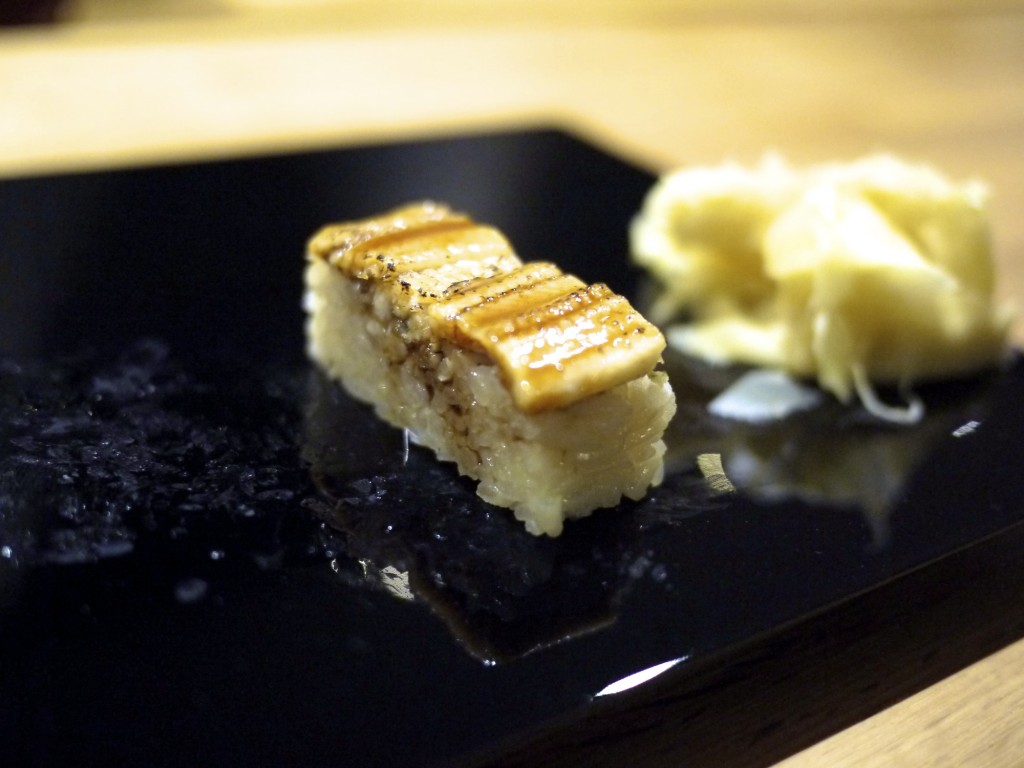 18th Course – Salt Water Eel / Anago (穴子): The final dish of the set menu was another pressed sushi of eel. As noted in my previous write up, there’s a lot of skill required to preparing eel that takes years of practice and experience. I found the kabayaki sauce on the lighter side compared to the usual sticky rich sauce you get in Japan. In addition, the flavour of the eel was bland.
18th Course – Salt Water Eel / Anago (穴子): The final dish of the set menu was another pressed sushi of eel. As noted in my previous write up, there’s a lot of skill required to preparing eel that takes years of practice and experience. I found the kabayaki sauce on the lighter side compared to the usual sticky rich sauce you get in Japan. In addition, the flavour of the eel was bland.
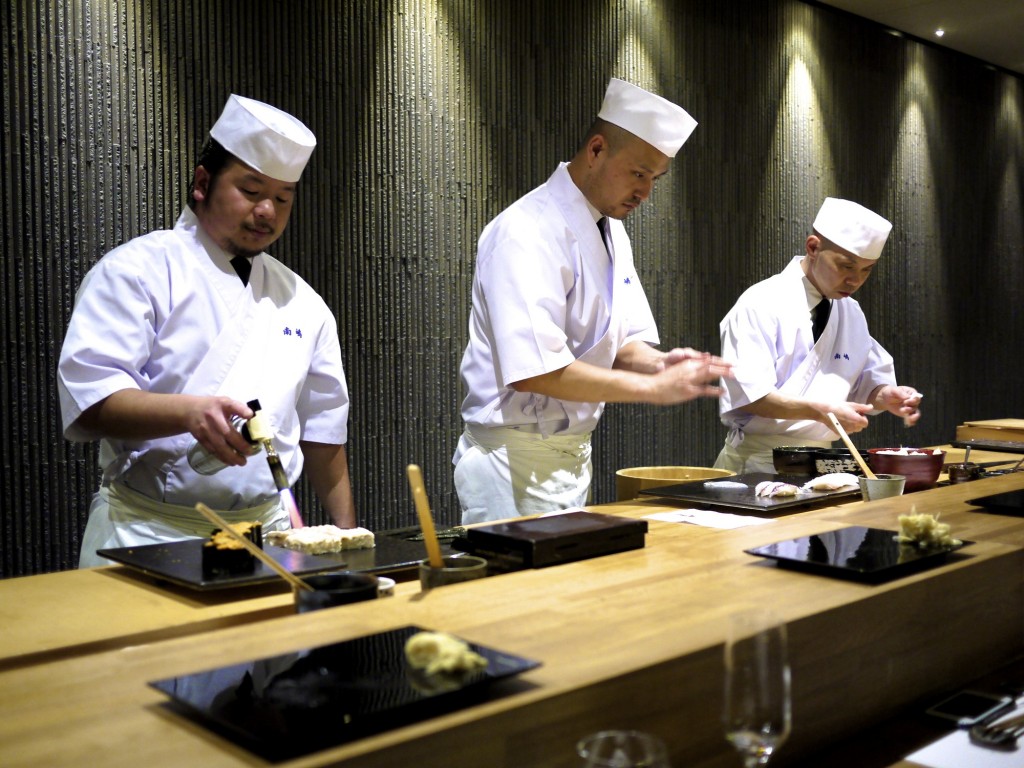 As we pondered on what additional nigiri’s we were going to order, Chef Minamishima’s right hand man Hajime Horiguchi (middle above) joined the chefs to keep up with the order that were piling in. They worked meticulously in sync and the speed at which the sushi’s were being sent out to the bigger tables was truly amazing.
As we pondered on what additional nigiri’s we were going to order, Chef Minamishima’s right hand man Hajime Horiguchi (middle above) joined the chefs to keep up with the order that were piling in. They worked meticulously in sync and the speed at which the sushi’s were being sent out to the bigger tables was truly amazing.
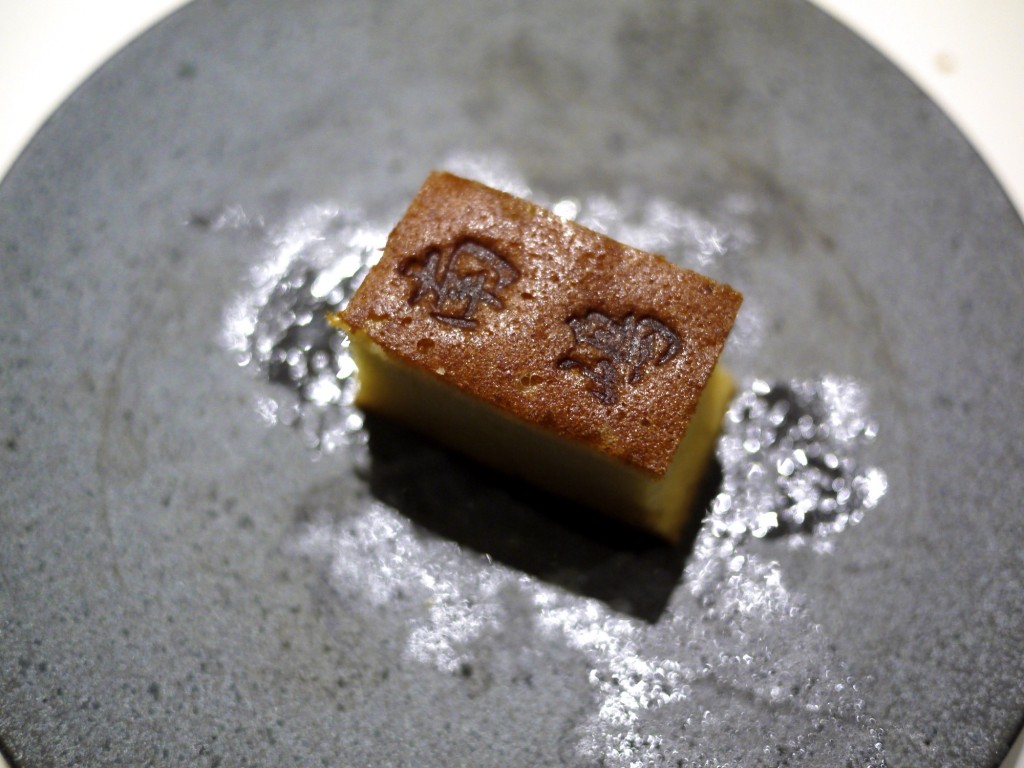 19th Course – Sweet Egg Cake / Tamagoyaki (卵焼き): This one was with a twist. The tamagoyaki was made more like a castella-styled cake which the Portuguese brought to Japan in the 16th Century. It had a lovely sweetness and moisture.
19th Course – Sweet Egg Cake / Tamagoyaki (卵焼き): This one was with a twist. The tamagoyaki was made more like a castella-styled cake which the Portuguese brought to Japan in the 16th Century. It had a lovely sweetness and moisture.
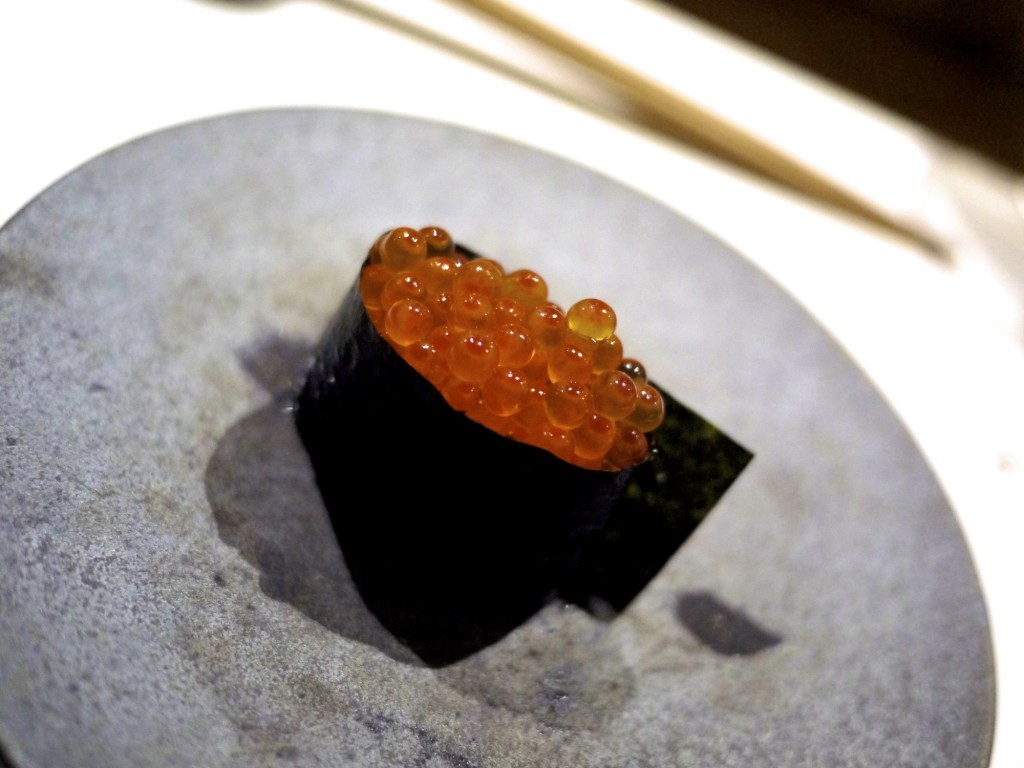 20th Course – Salmon Roe / Ikura (イクラ): In addition to re-ordering the flounder, sea perch and seared ootoro, I could not go away without asking for my childhood favourite of the salmon roe. The salmon roe sourced from Tasmania was firm enough to be individually savoured but in my opinion, marinating the salmon roe in soy sauce would have elevated this dish further.
20th Course – Salmon Roe / Ikura (イクラ): In addition to re-ordering the flounder, sea perch and seared ootoro, I could not go away without asking for my childhood favourite of the salmon roe. The salmon roe sourced from Tasmania was firm enough to be individually savoured but in my opinion, marinating the salmon roe in soy sauce would have elevated this dish further.
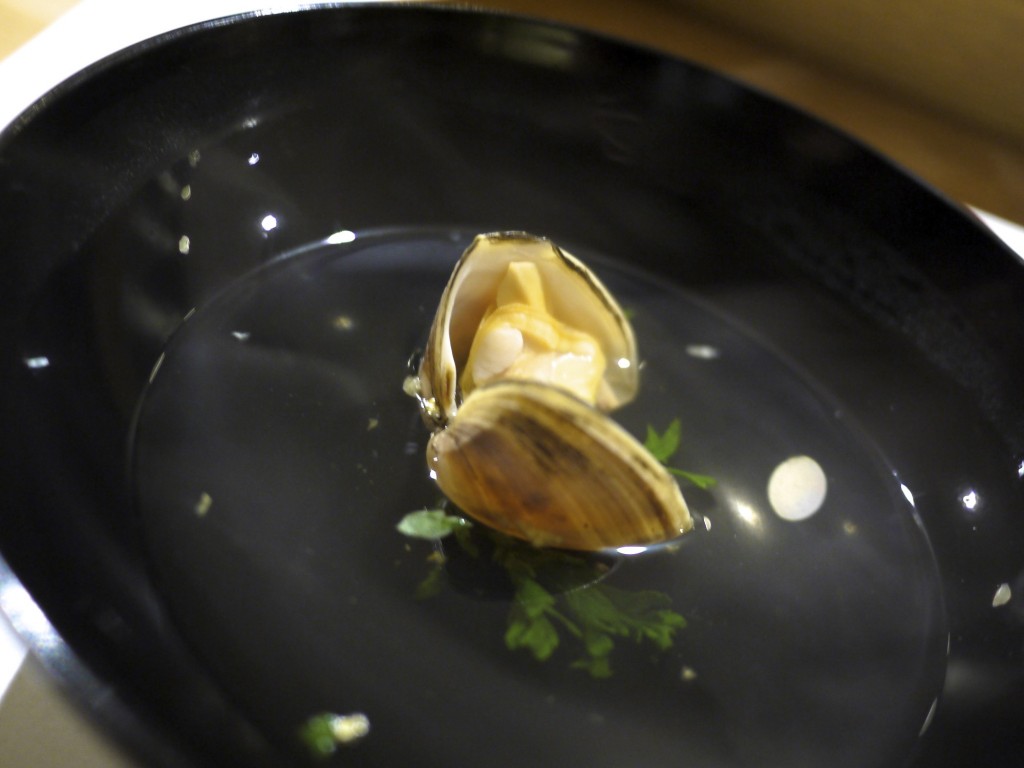 21st Course – Diamond Clam and dashi: A sweet and chewy clam suimono that washed away the lingering flavour of sushi before jumping on to the finale of the dessert.
21st Course – Diamond Clam and dashi: A sweet and chewy clam suimono that washed away the lingering flavour of sushi before jumping on to the finale of the dessert.
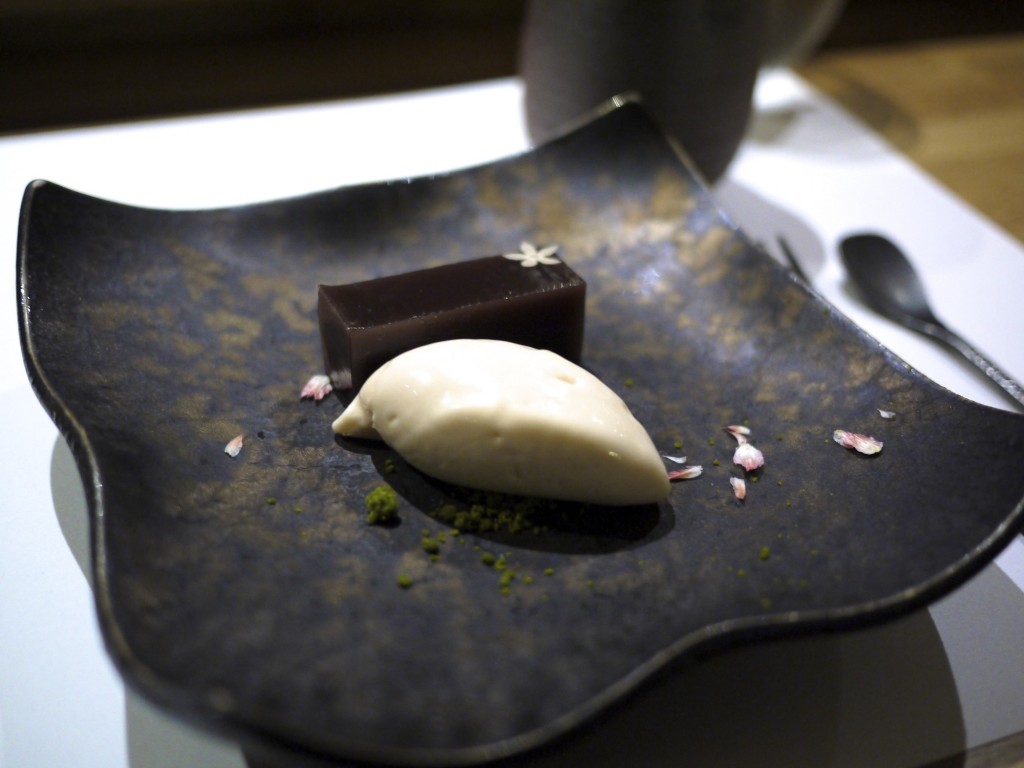 22nd Course – Yokan and Cherry Blossom ice cream: The yokan (red bean paste cake) was smooth and washed down ever so well with the hot tea. The cherry blossom ice cream left a floral aftertaste and the bitter matcha (green tea) contrasted ever so well to the sweet and rich yokan.
22nd Course – Yokan and Cherry Blossom ice cream: The yokan (red bean paste cake) was smooth and washed down ever so well with the hot tea. The cherry blossom ice cream left a floral aftertaste and the bitter matcha (green tea) contrasted ever so well to the sweet and rich yokan.
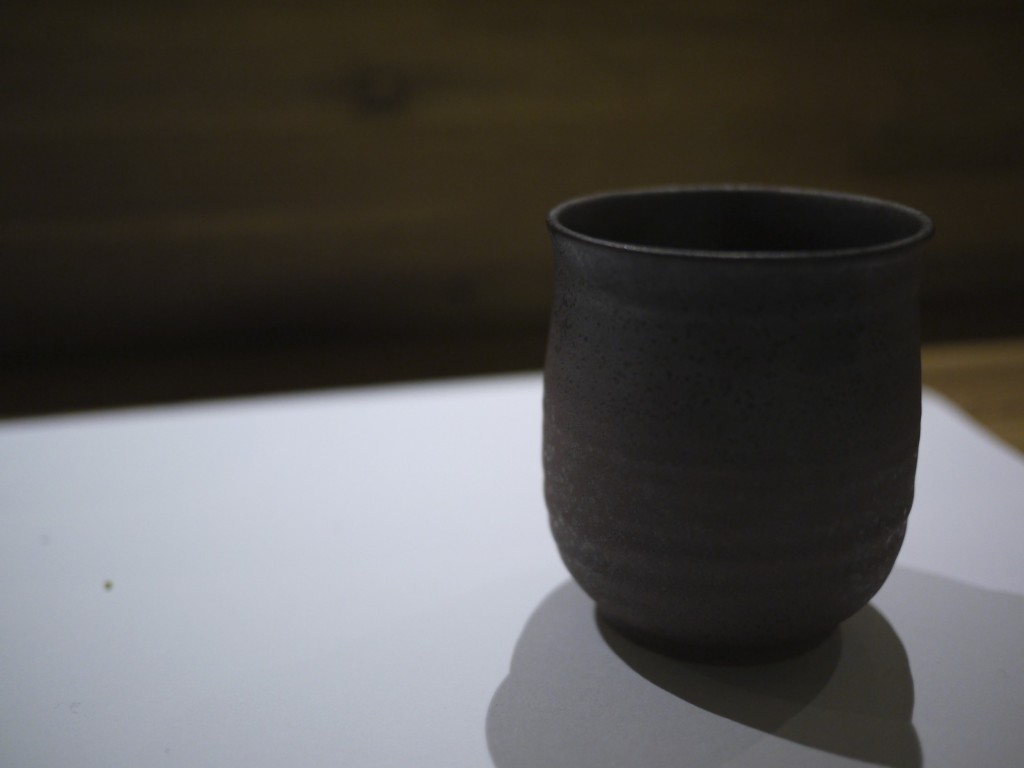 All in all Minamishima for me was a success despite a couple of missteps, the sinew of the ootoro for instance comes to mind. However, it shows a lot of promise and certainly exceed the level of sushi I’ve encountered in Melbourne, let alone Australia. Sure, it wasn’t on par with Kanesaka in Singapore or Sushi Tetsu in London but it showed promise with great innovations like the flounder’s fin nigiri which literally just blew me away. It would be interesting to see what creative dishes Chef Minamishima comes up with in the future.
All in all Minamishima for me was a success despite a couple of missteps, the sinew of the ootoro for instance comes to mind. However, it shows a lot of promise and certainly exceed the level of sushi I’ve encountered in Melbourne, let alone Australia. Sure, it wasn’t on par with Kanesaka in Singapore or Sushi Tetsu in London but it showed promise with great innovations like the flounder’s fin nigiri which literally just blew me away. It would be interesting to see what creative dishes Chef Minamishima comes up with in the future.
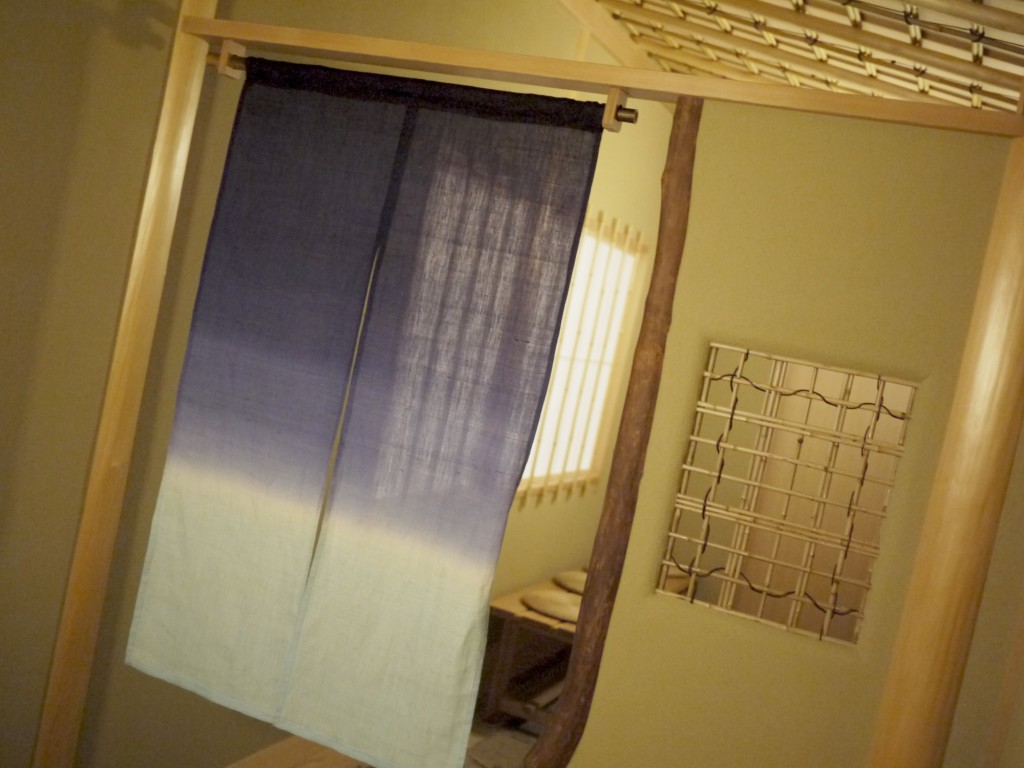 Harutaka occupies the entire third floor of the building and offers 12 counter seating and 1 private room for an additional 4 people. The restaurant is only open in the evenings and serves a standard omakase menu at approximately 30,000 yen. Unlike his mentor, his menu offers other otsumami (snacks) and comes with less attitude. Contrary to the experience I had endured the night before at Shimizu, the environment here was more relaxed. Chef Harutaka even offered an English sushi dictionary to my wife who was the only foreigner dining that evening, which was kindly received.
Harutaka occupies the entire third floor of the building and offers 12 counter seating and 1 private room for an additional 4 people. The restaurant is only open in the evenings and serves a standard omakase menu at approximately 30,000 yen. Unlike his mentor, his menu offers other otsumami (snacks) and comes with less attitude. Contrary to the experience I had endured the night before at Shimizu, the environment here was more relaxed. Chef Harutaka even offered an English sushi dictionary to my wife who was the only foreigner dining that evening, which was kindly received.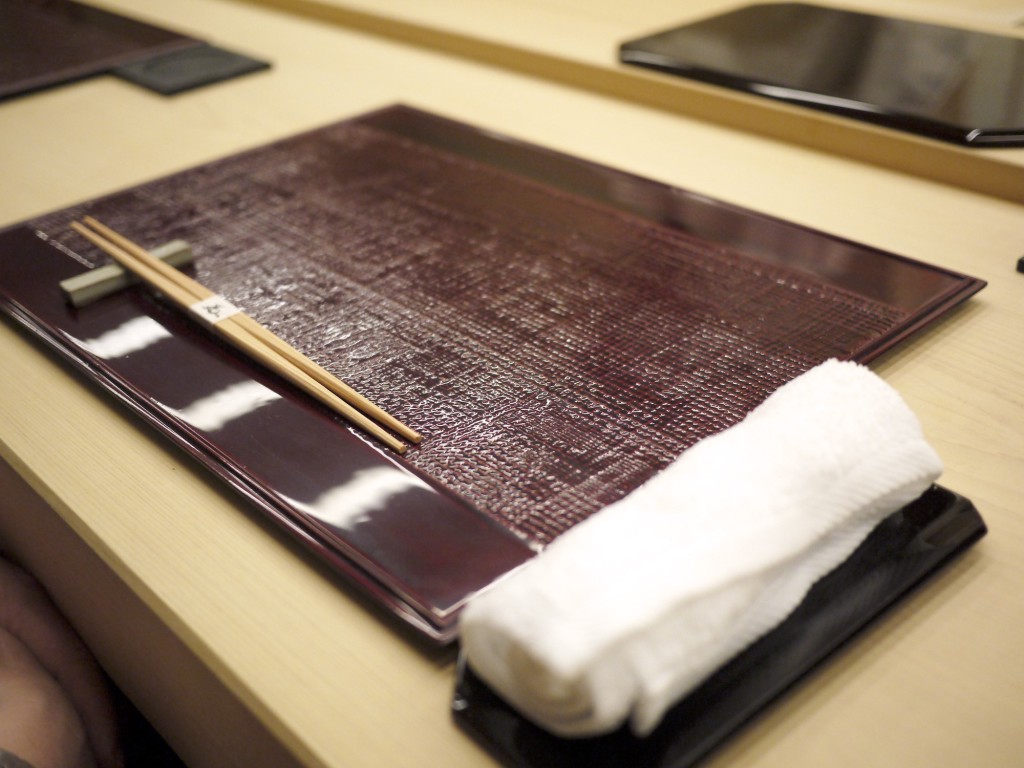 Harutaka is well known for his use of rice vinegar in his shari (rice) and superior quality of neta (topping). Whilst foreigners appear to have a more divided opinion on his sushi, the locals overwhelmingly rate positively the way in which he prepares his shari. There’s a slight sharpness from the vinegar, followed by a slight saltiness, finishing with the natural sweetness of the rice.
Harutaka is well known for his use of rice vinegar in his shari (rice) and superior quality of neta (topping). Whilst foreigners appear to have a more divided opinion on his sushi, the locals overwhelmingly rate positively the way in which he prepares his shari. There’s a slight sharpness from the vinegar, followed by a slight saltiness, finishing with the natural sweetness of the rice.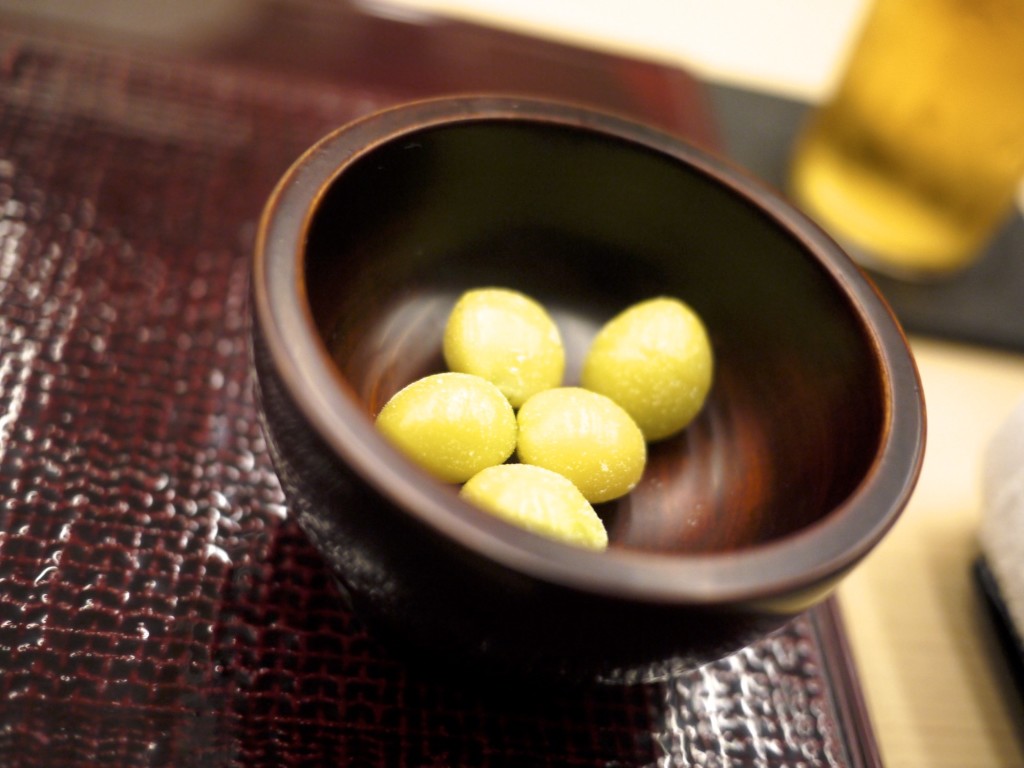 Appetiser – Gingko (銀杏) served slightly warm and sprinkled with salt. Certainly whet our appetite.
Appetiser – Gingko (銀杏) served slightly warm and sprinkled with salt. Certainly whet our appetite.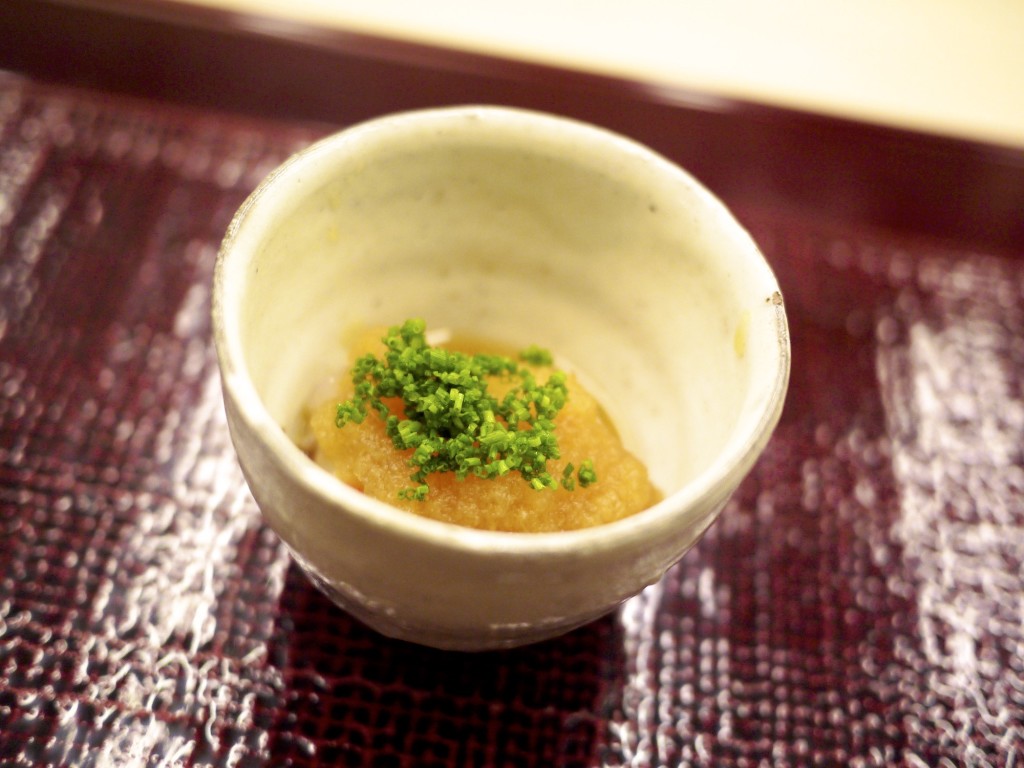 1st course – Japanese Tiger Prawns (kurumaebi) with Japanese radish (daikon) and ponzu. The sweet tiger prawns from Kyushu were served raw in a sashimi style and married well with the daikon and slightly sharp ponzu.
1st course – Japanese Tiger Prawns (kurumaebi) with Japanese radish (daikon) and ponzu. The sweet tiger prawns from Kyushu were served raw in a sashimi style and married well with the daikon and slightly sharp ponzu. 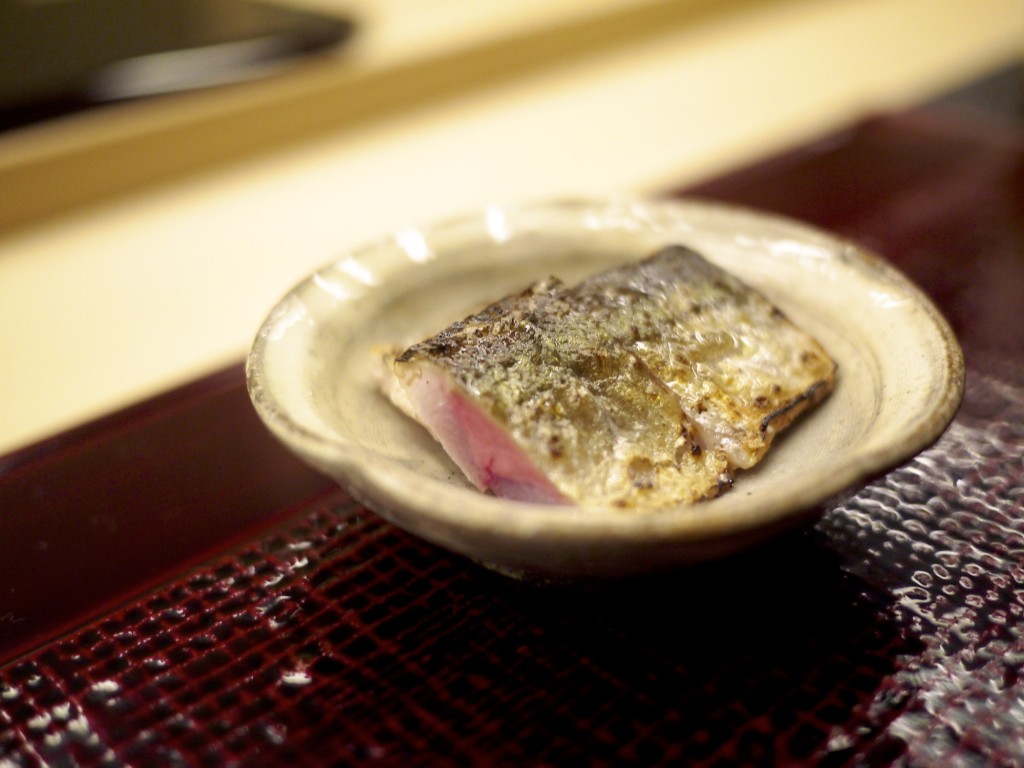 2nd Course – Pacific Saury / Sanma (サンマ). Slightly grilled with salt creating a lovely contrast of the crispy skin and the soft flesh of the fish.
2nd Course – Pacific Saury / Sanma (サンマ). Slightly grilled with salt creating a lovely contrast of the crispy skin and the soft flesh of the fish. 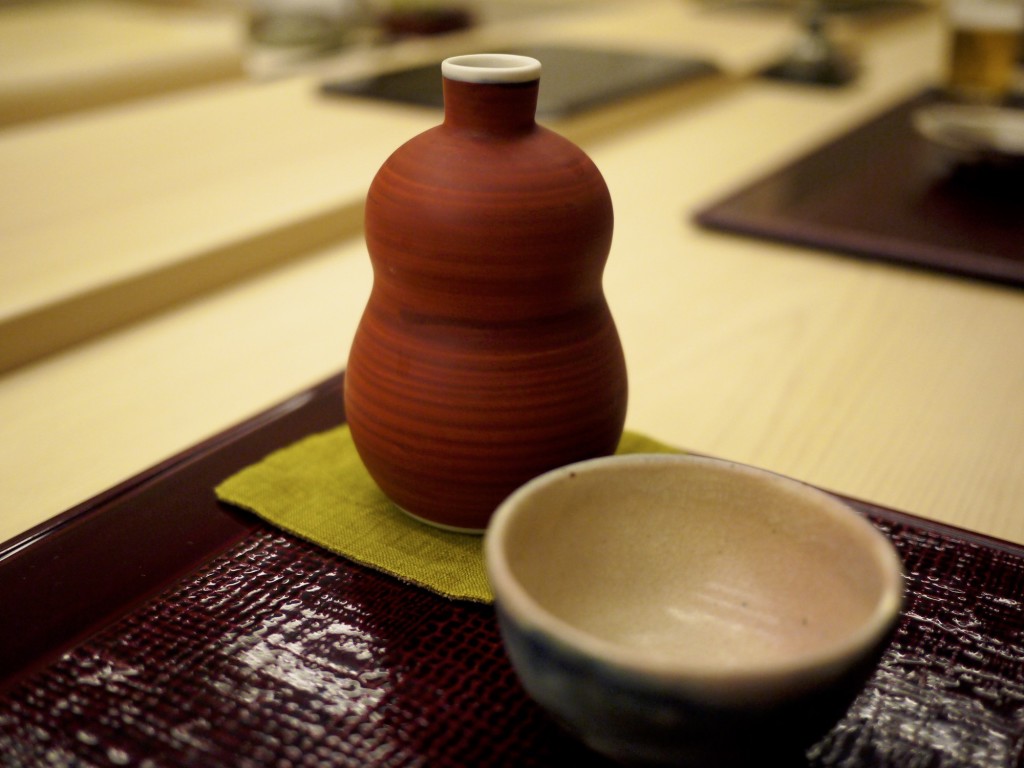 Sake – Yoemon – Junmai. A perfect timing for the arrival of my sake for the evening. It went down really well with my grilled fish at a modest price of only 3,000 yen per tokkuri.
Sake – Yoemon – Junmai. A perfect timing for the arrival of my sake for the evening. It went down really well with my grilled fish at a modest price of only 3,000 yen per tokkuri.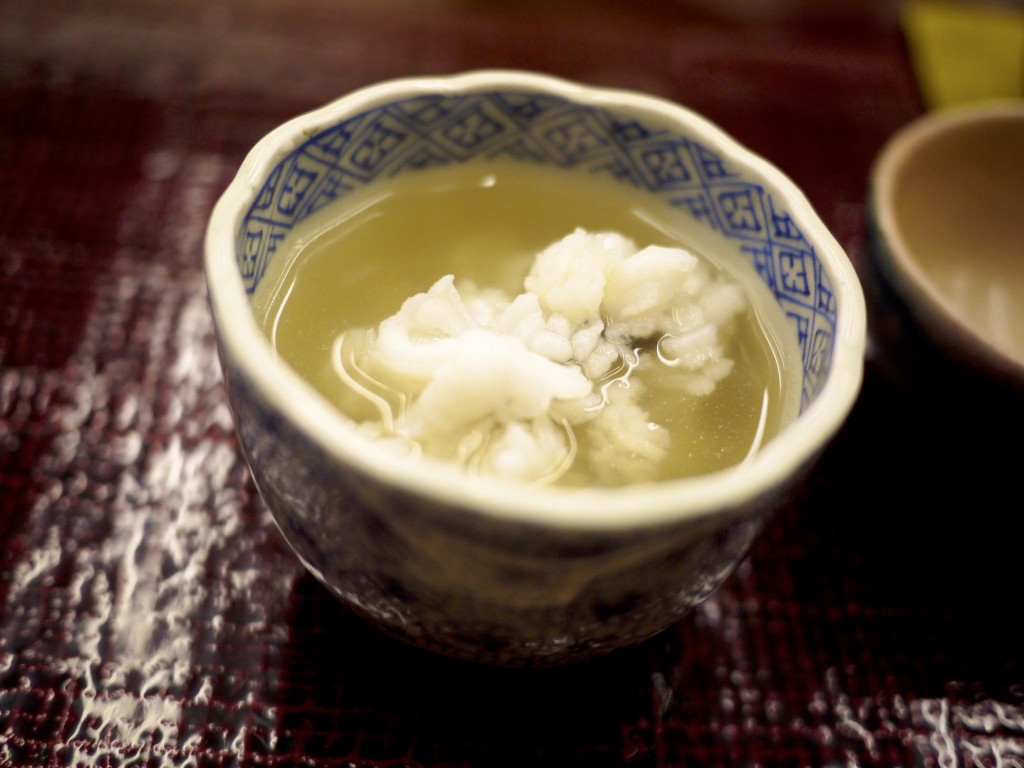 3rd Course – Conger pike (Hamo) with matsutake broth. The umami from the dashi used for the broth was superb and really worked well by drawing out the flavour of the delicate conger pike. There was also a slight hint of plum and vinegar which complemented the fish.
3rd Course – Conger pike (Hamo) with matsutake broth. The umami from the dashi used for the broth was superb and really worked well by drawing out the flavour of the delicate conger pike. There was also a slight hint of plum and vinegar which complemented the fish. 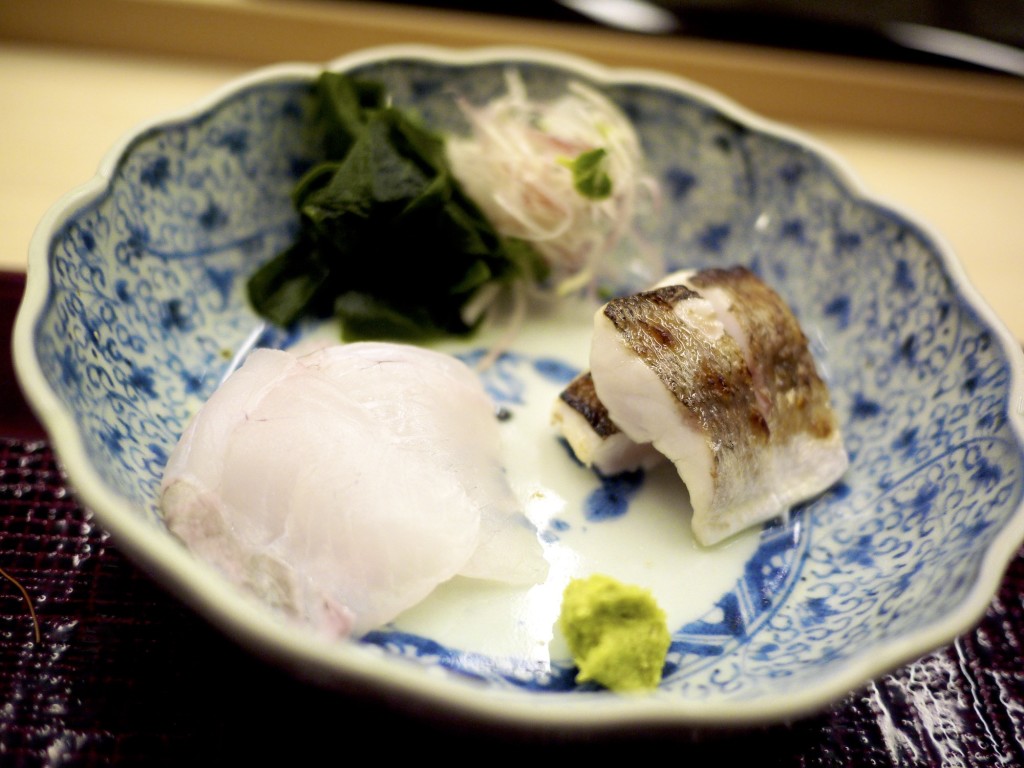 4th Course – Sashimi of Flounder / Hirame (平目) and slightly grilled barracuda / kamasu (梭子魚). A great combination of flavours between the sweetness of the flounder which becomes very fatty during autumn contrasted with the strong flavour the lean barracuda.
4th Course – Sashimi of Flounder / Hirame (平目) and slightly grilled barracuda / kamasu (梭子魚). A great combination of flavours between the sweetness of the flounder which becomes very fatty during autumn contrasted with the strong flavour the lean barracuda.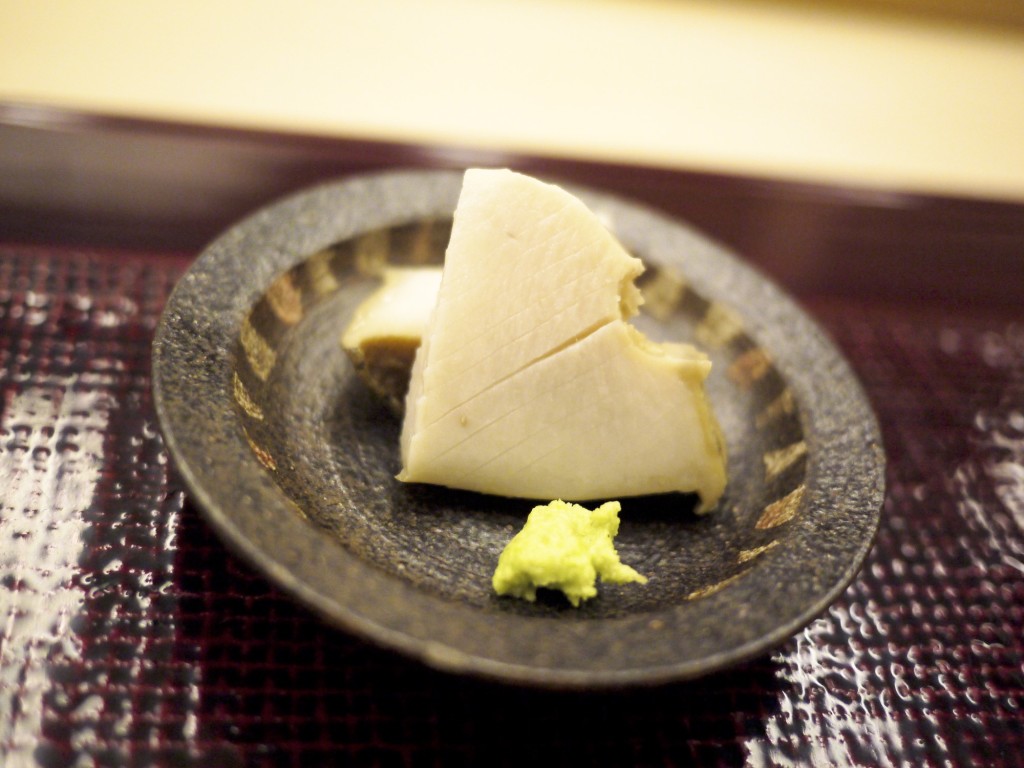 5th Course – Steamed abalone / mushiawabi (蒸し鮑) scorched with soy sauce. The abalone was steamed for 3.5 hours in sake before being sliced and scorched with soy sauce. It was perfect in every way with its scent, umami and crispiness. By far and beyond the best abalone my wife has ever had.
5th Course – Steamed abalone / mushiawabi (蒸し鮑) scorched with soy sauce. The abalone was steamed for 3.5 hours in sake before being sliced and scorched with soy sauce. It was perfect in every way with its scent, umami and crispiness. By far and beyond the best abalone my wife has ever had. 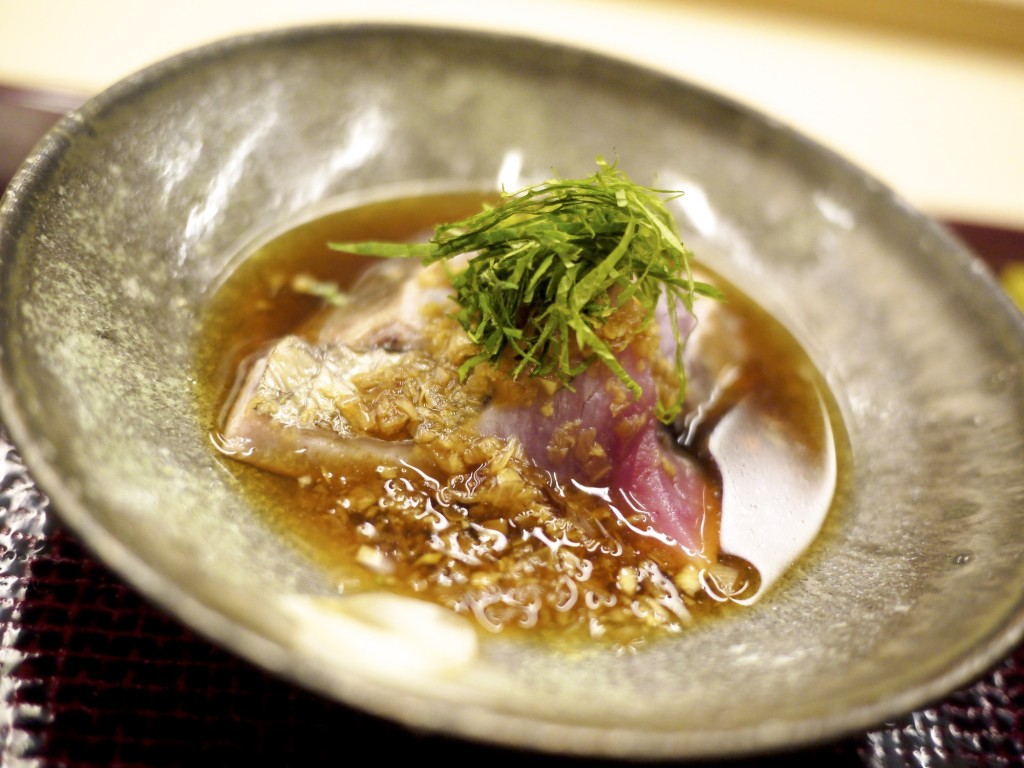 6th Course – Skipjack / Katsuo (鰹) with ginger soy sauce. This was our favourite course of the otsumami. There was a slight smokiness to the fish from the way in which he scorched it before dressing it with the ginger soy sauce.
6th Course – Skipjack / Katsuo (鰹) with ginger soy sauce. This was our favourite course of the otsumami. There was a slight smokiness to the fish from the way in which he scorched it before dressing it with the ginger soy sauce.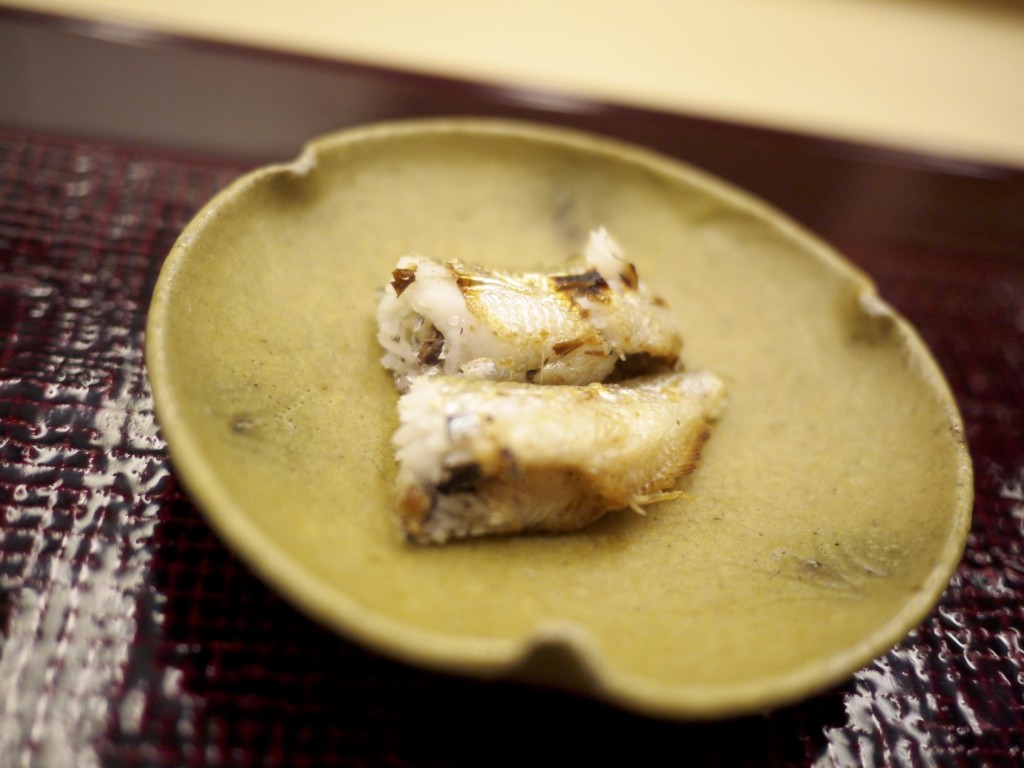 7th Course – Willow leaf fish / Shishamo (柳葉魚) sourced from Hokkaido. The flesh here was far more delicate and the flavours more subtle than others I have tasted before. Unlike the normal ones I’m use to at the typical izakayas, this one was completely absent of any bitter aftertaste.
7th Course – Willow leaf fish / Shishamo (柳葉魚) sourced from Hokkaido. The flesh here was far more delicate and the flavours more subtle than others I have tasted before. Unlike the normal ones I’m use to at the typical izakayas, this one was completely absent of any bitter aftertaste. 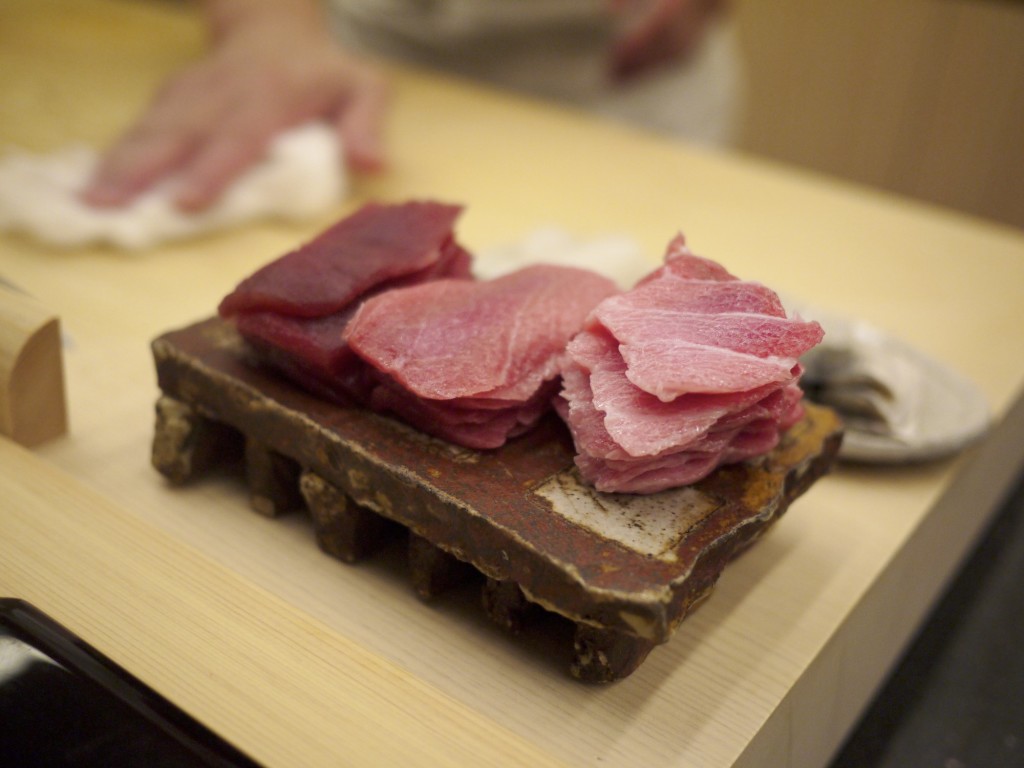 We looked over to see the chef preparing for the private dining room’s next few nigiris who were far ahead of us. The quality of the tuna looked very good.
We looked over to see the chef preparing for the private dining room’s next few nigiris who were far ahead of us. The quality of the tuna looked very good.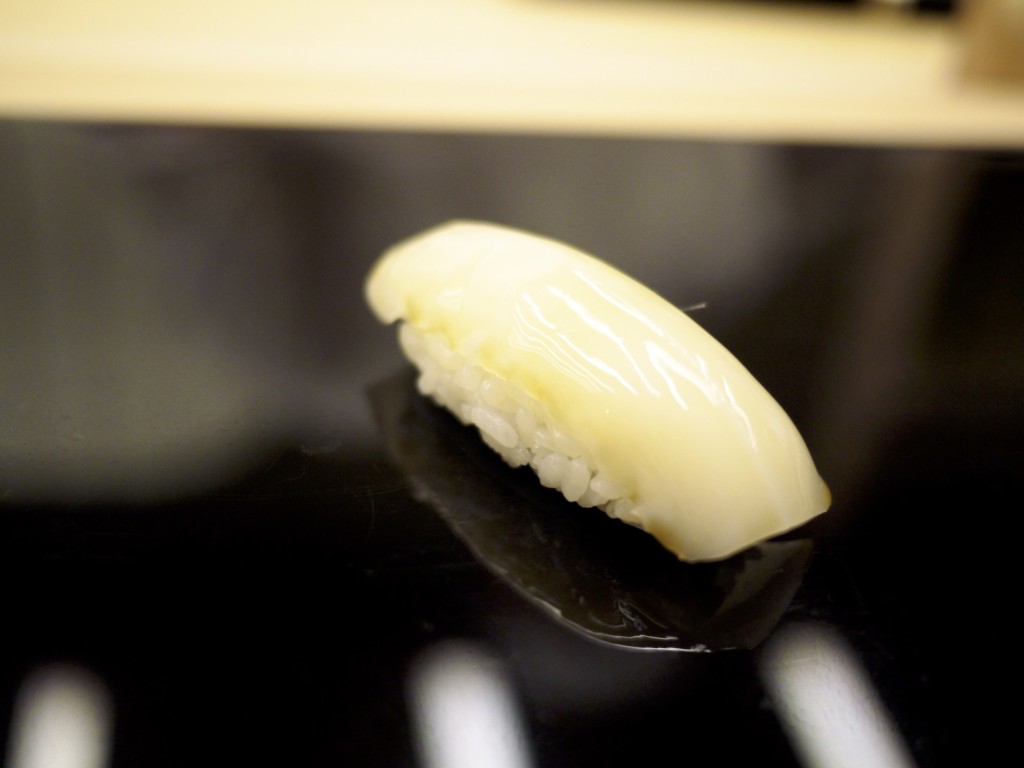 8th Course – Squid / Sumi ika (スミイカ). Our first sushi was a silky and tender ink squid. Absent of any rubbery texture, this was as good as squid goes.
8th Course – Squid / Sumi ika (スミイカ). Our first sushi was a silky and tender ink squid. Absent of any rubbery texture, this was as good as squid goes.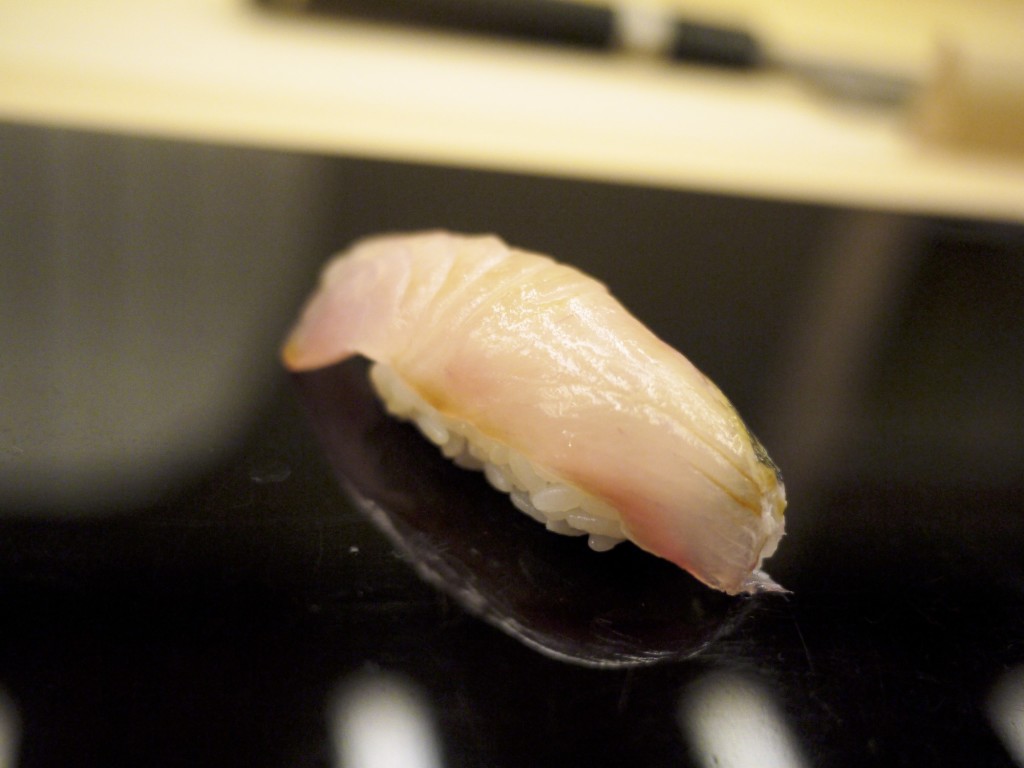 9th Course – Striped Jack / Shima aji (縞鯵). An impressive sushi with an incredible sweetness and fattiness from the slightly pickled fish competing with the slightly sharp shari.
9th Course – Striped Jack / Shima aji (縞鯵). An impressive sushi with an incredible sweetness and fattiness from the slightly pickled fish competing with the slightly sharp shari. 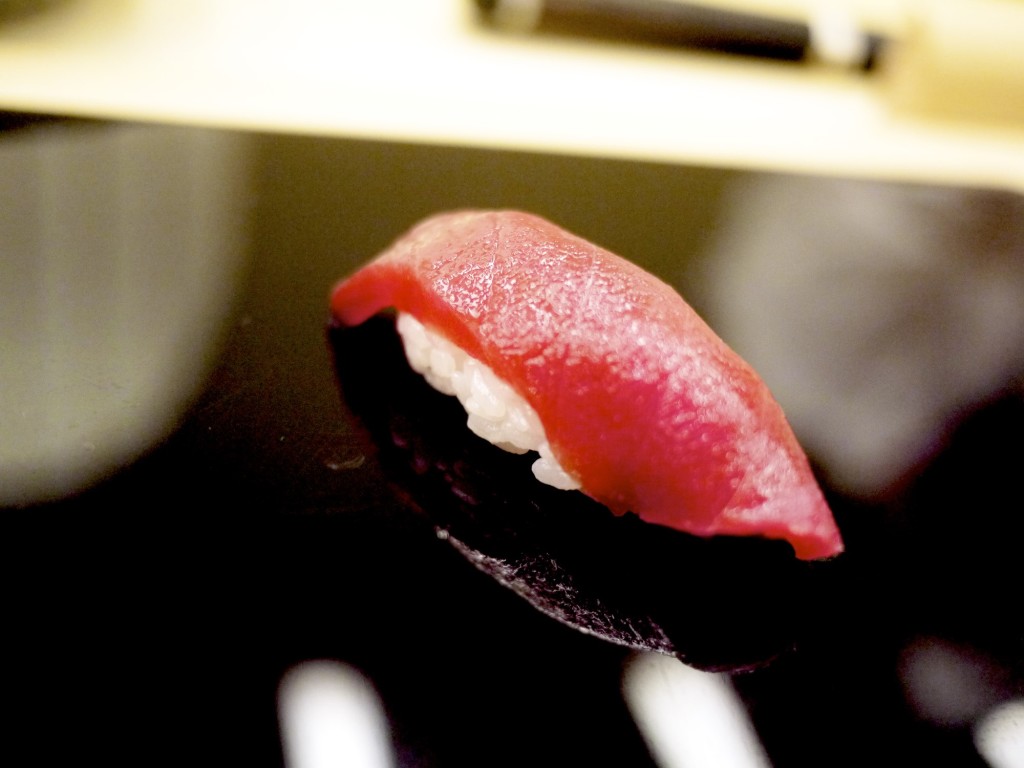 10th Course – Lean part of the Tuna / Akami (鮪赤身). The shari actually worked best here with the tuna. Attention to detail here was important and my wife’s tea was changed just before the akami was served (it is common practice to change the tea when tuna is served to cleanse your palate between the tuna courses and bring the temperature of the tea up again).
10th Course – Lean part of the Tuna / Akami (鮪赤身). The shari actually worked best here with the tuna. Attention to detail here was important and my wife’s tea was changed just before the akami was served (it is common practice to change the tea when tuna is served to cleanse your palate between the tuna courses and bring the temperature of the tea up again).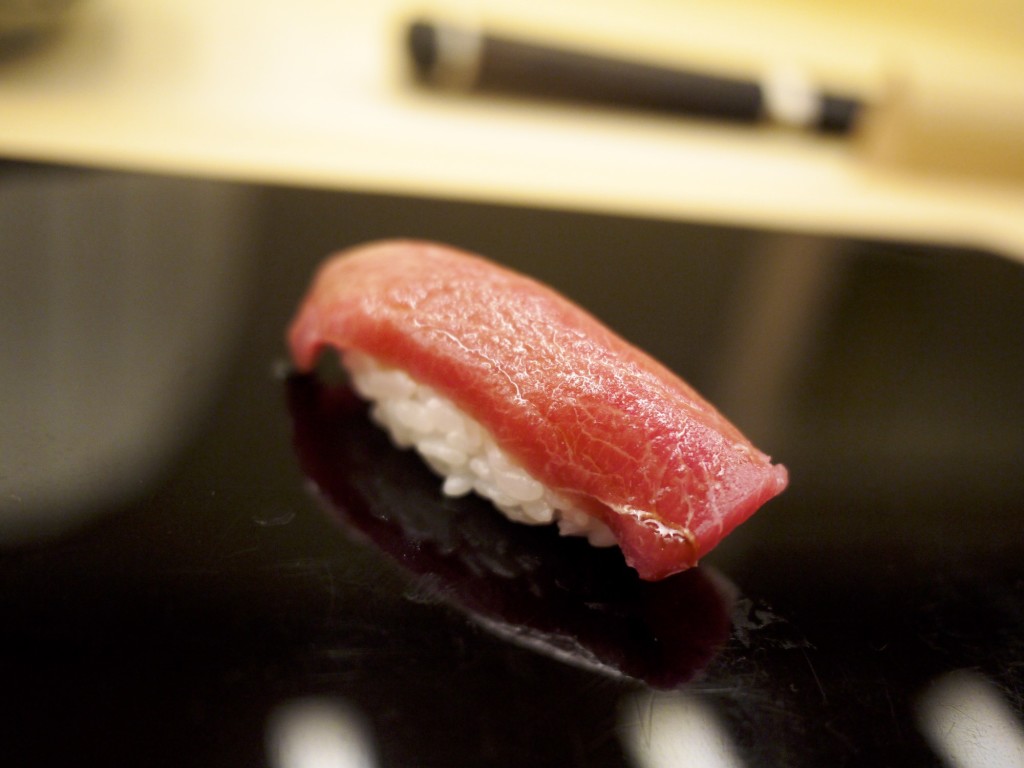 11th Course – Medium fatty tuna / Chuutoro (鮪中トロ). An absolute masterpiece of nigiri. The sweetness and fattiness of the tuna penetrated right through the sharp and salty shari. A match made in heaven with no lingering fatty aftertaste. This was probably the best chuutoro I’ve ever had.
11th Course – Medium fatty tuna / Chuutoro (鮪中トロ). An absolute masterpiece of nigiri. The sweetness and fattiness of the tuna penetrated right through the sharp and salty shari. A match made in heaven with no lingering fatty aftertaste. This was probably the best chuutoro I’ve ever had.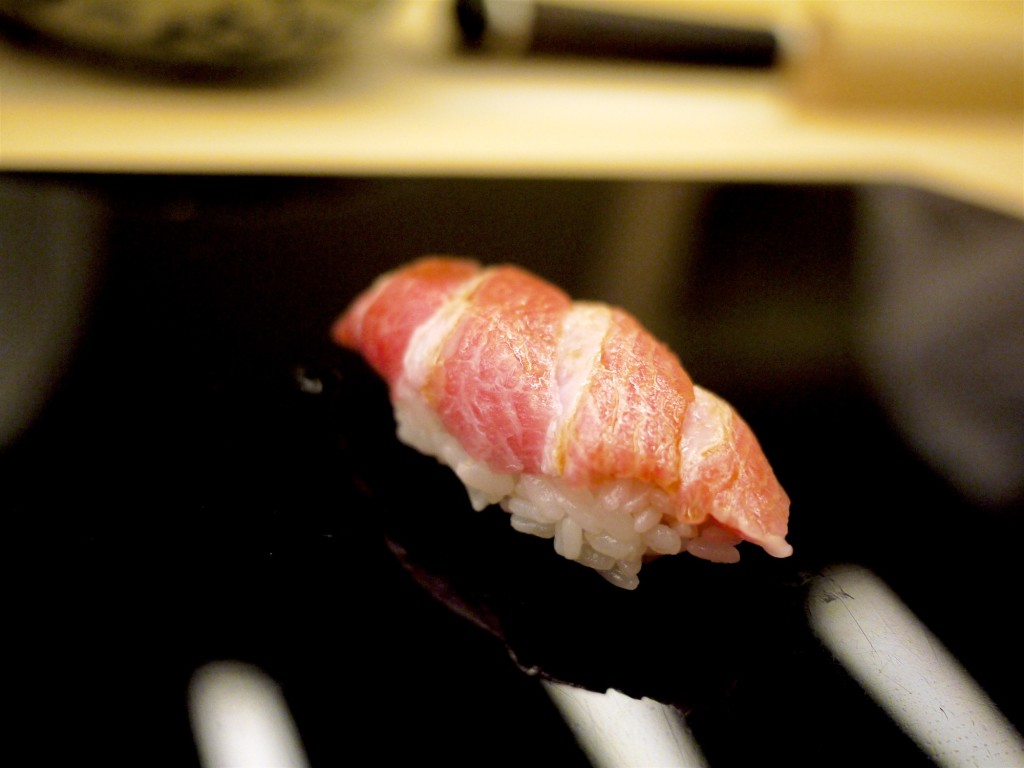 12th Course – Fatty Tuna / ootoro (鮪大トロ). A lovely cut of tuna but personally I felt the combination of the medium fatty tuna and the shari was superior. Each to their own I guess! It did however allow us to appreciate the different textures and flavours of the whole fish.
12th Course – Fatty Tuna / ootoro (鮪大トロ). A lovely cut of tuna but personally I felt the combination of the medium fatty tuna and the shari was superior. Each to their own I guess! It did however allow us to appreciate the different textures and flavours of the whole fish.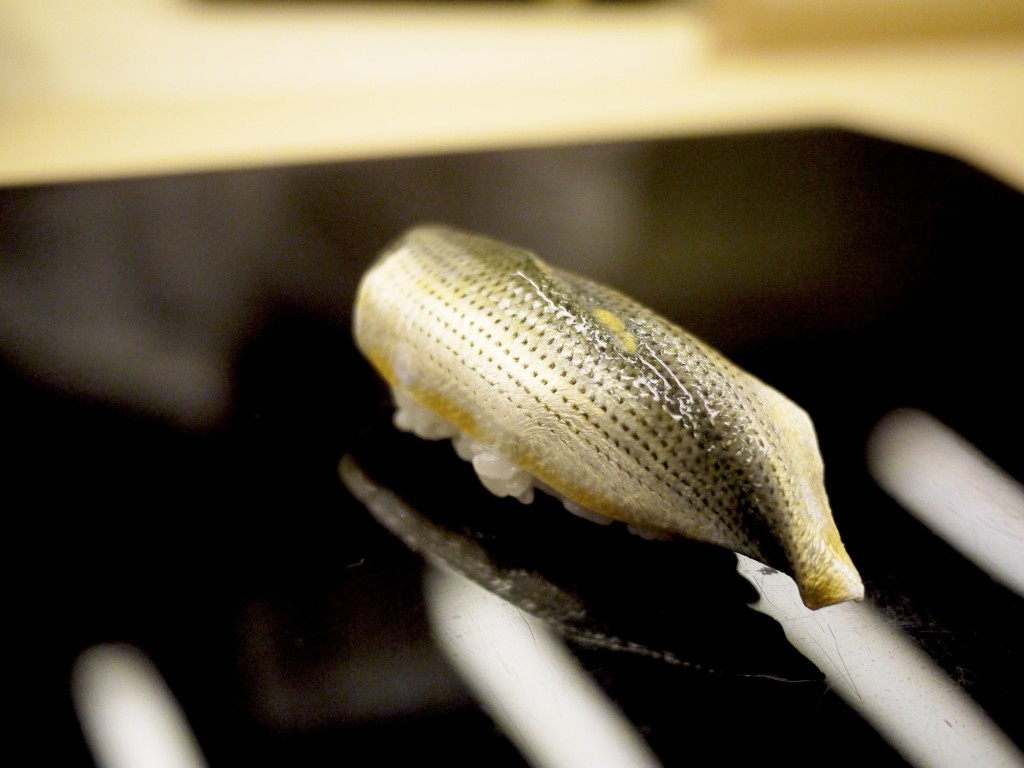 13th Course – Gizzard shad / Kohada (小鰭). This nigiri required a labour of love in order to remove the distinct smell, leaving only a peasant oiliness and sweetness behind. The fish was sourced from Amakusa in Kumamoto prefecture. I was pleasantly surprised with the quality given the best season to fish is normally November / December, and we were a month early.
13th Course – Gizzard shad / Kohada (小鰭). This nigiri required a labour of love in order to remove the distinct smell, leaving only a peasant oiliness and sweetness behind. The fish was sourced from Amakusa in Kumamoto prefecture. I was pleasantly surprised with the quality given the best season to fish is normally November / December, and we were a month early.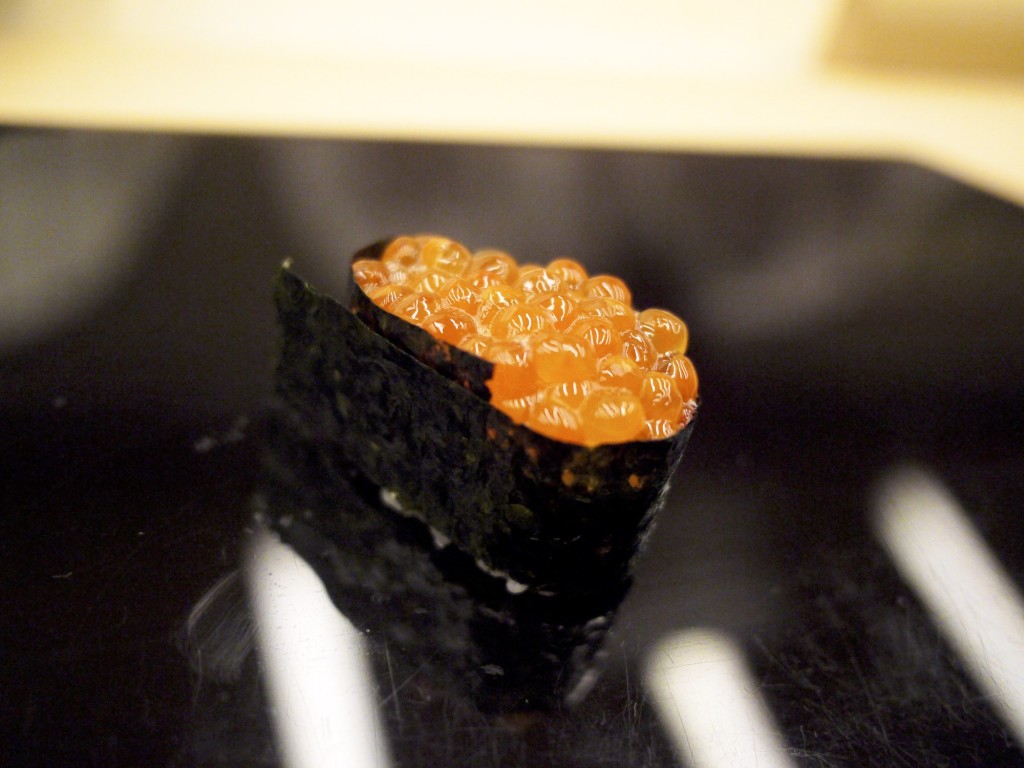 14th Course – Salmon Roe / Ikura (イクラ). An all time favourite of mine since I was a kid and this certainly didn’t disappoint. The salmon roe was slightly pickled in soy sauce to enhance the flavour. Each pearl burst with a gooey delicious salty juice.
14th Course – Salmon Roe / Ikura (イクラ). An all time favourite of mine since I was a kid and this certainly didn’t disappoint. The salmon roe was slightly pickled in soy sauce to enhance the flavour. Each pearl burst with a gooey delicious salty juice. 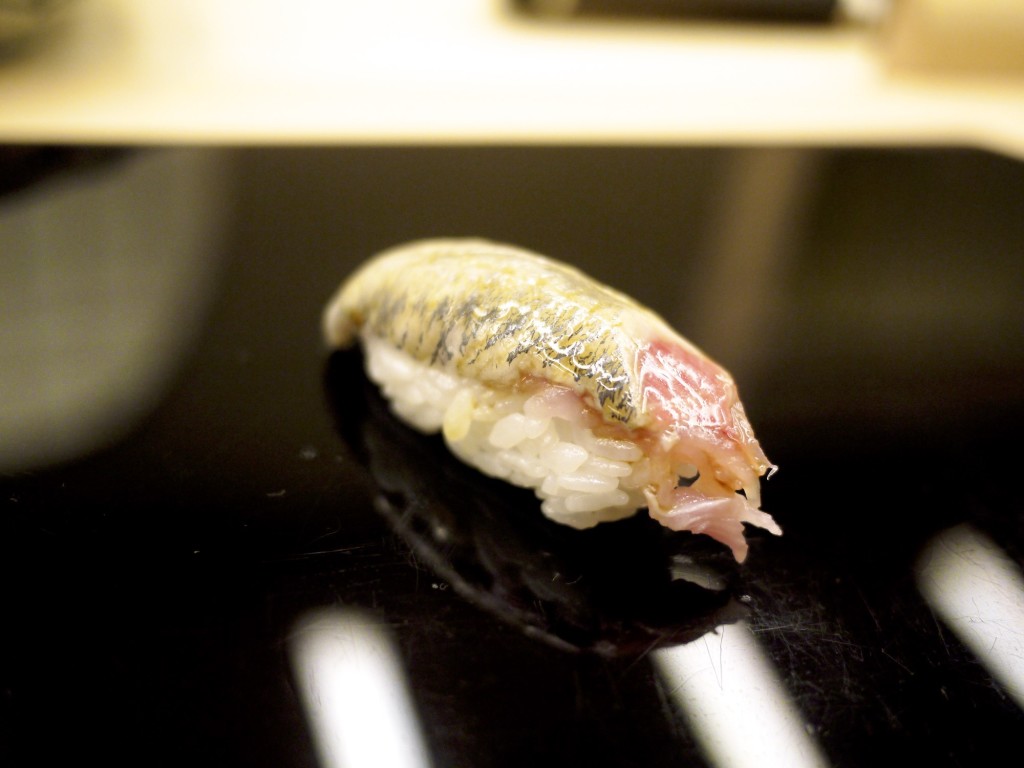 15th Course – Japanese Pilchard / Iwashi (いわし). This nigiri was my personal favourite of the evening. The umami was incredible and it just melted in your mouth with little effort like a slice of the finest iberico ham. The slight bit of ginger underneath cut through oiliness of the fish.
15th Course – Japanese Pilchard / Iwashi (いわし). This nigiri was my personal favourite of the evening. The umami was incredible and it just melted in your mouth with little effort like a slice of the finest iberico ham. The slight bit of ginger underneath cut through oiliness of the fish. 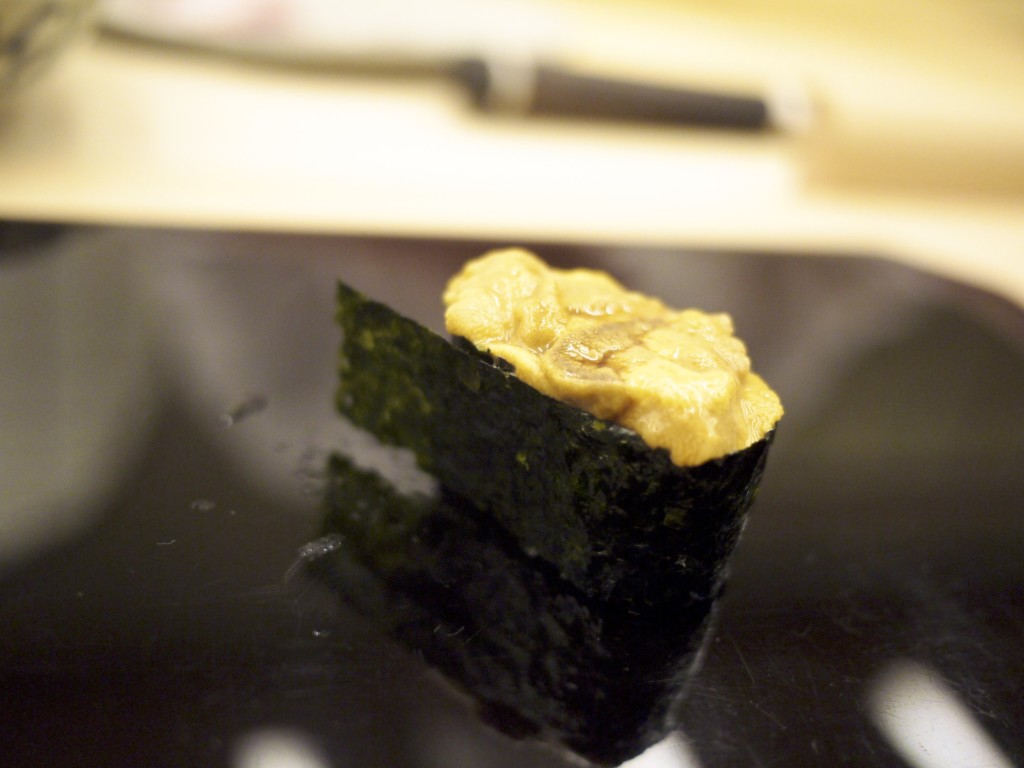 16th Course – Sea urchin / Uni (雲丹). A classic nigiri which required very little interference. Sourced from Hokkaido again, this was a beautifully sweet, creamy and absent of any bitter aftertaste.
16th Course – Sea urchin / Uni (雲丹). A classic nigiri which required very little interference. Sourced from Hokkaido again, this was a beautifully sweet, creamy and absent of any bitter aftertaste.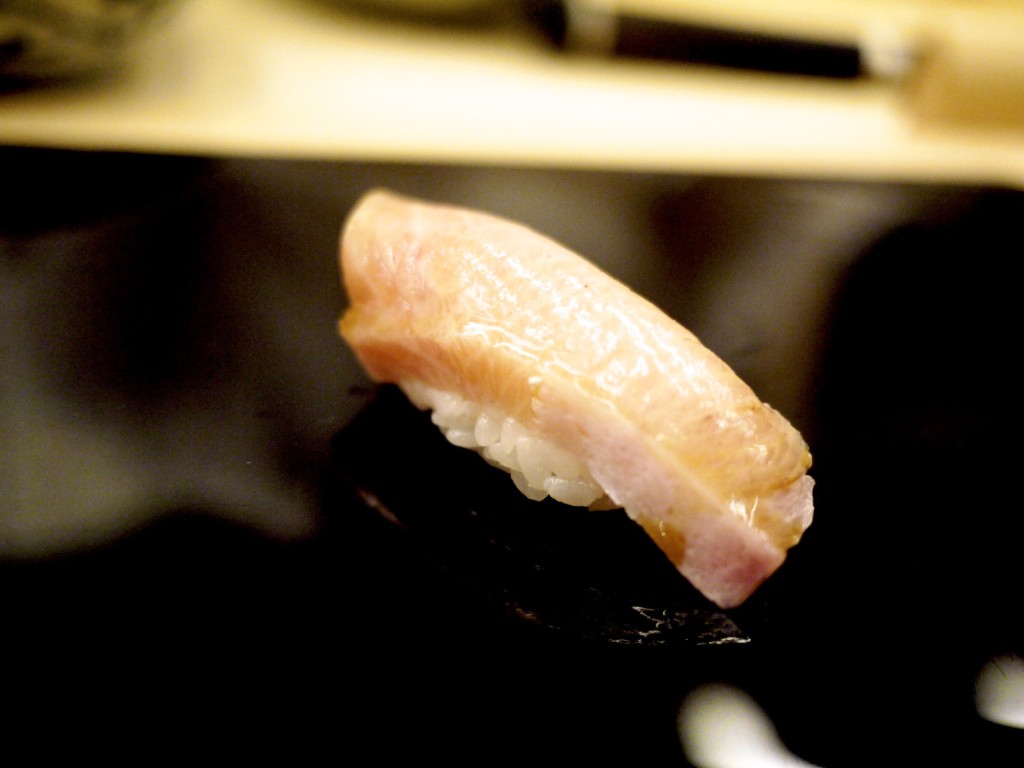 17th Course – Amberjack / Buri (鰤). Sourced from Himi at Toyama prefecture, home to one of the best amberjack in Japan. I did however find that the vinegar rice and the fish on this occasion wasn’t quite the perfect match, although the quality and preparation of the fish was second to none.
17th Course – Amberjack / Buri (鰤). Sourced from Himi at Toyama prefecture, home to one of the best amberjack in Japan. I did however find that the vinegar rice and the fish on this occasion wasn’t quite the perfect match, although the quality and preparation of the fish was second to none.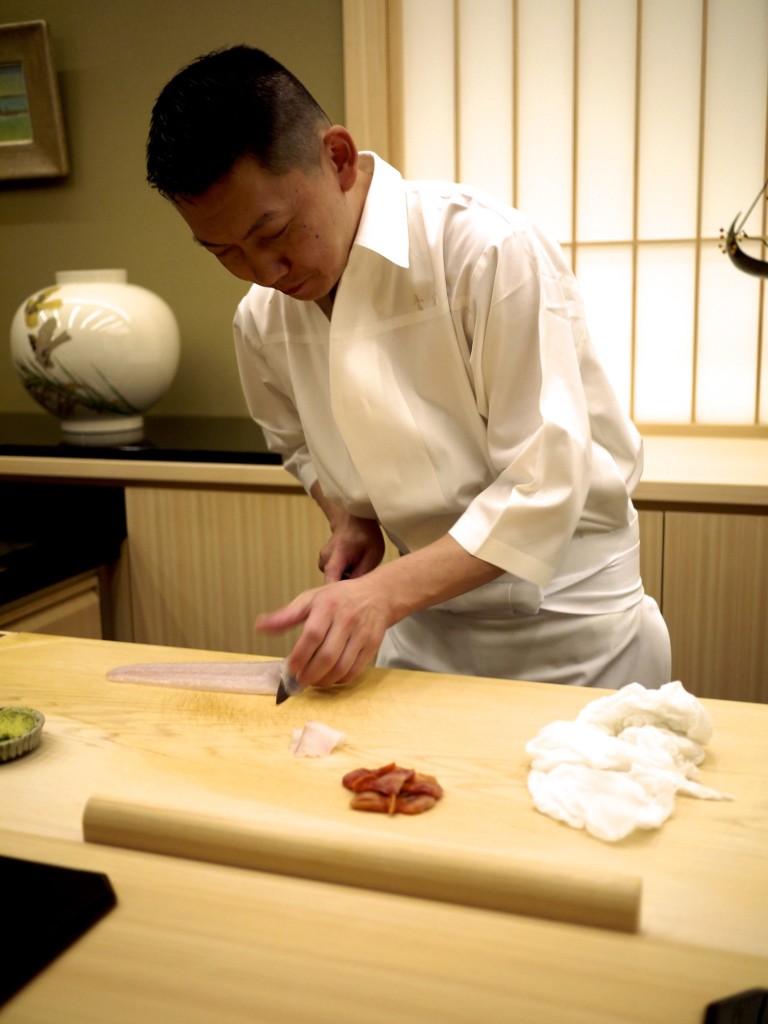 Chef Harutaka spoke very little English but was happy to answer any question I translated for my wife. Whilst he was very focused in his job, meticulously preparing each nigiri, we couldn’t help but notice that he looked like he was having fun. Perhaps it was the cheerful crowd of three sitting at the other end of the counter (they appear to have been celebrities), but he certainly did not stop smiling all evening.
Chef Harutaka spoke very little English but was happy to answer any question I translated for my wife. Whilst he was very focused in his job, meticulously preparing each nigiri, we couldn’t help but notice that he looked like he was having fun. Perhaps it was the cheerful crowd of three sitting at the other end of the counter (they appear to have been celebrities), but he certainly did not stop smiling all evening.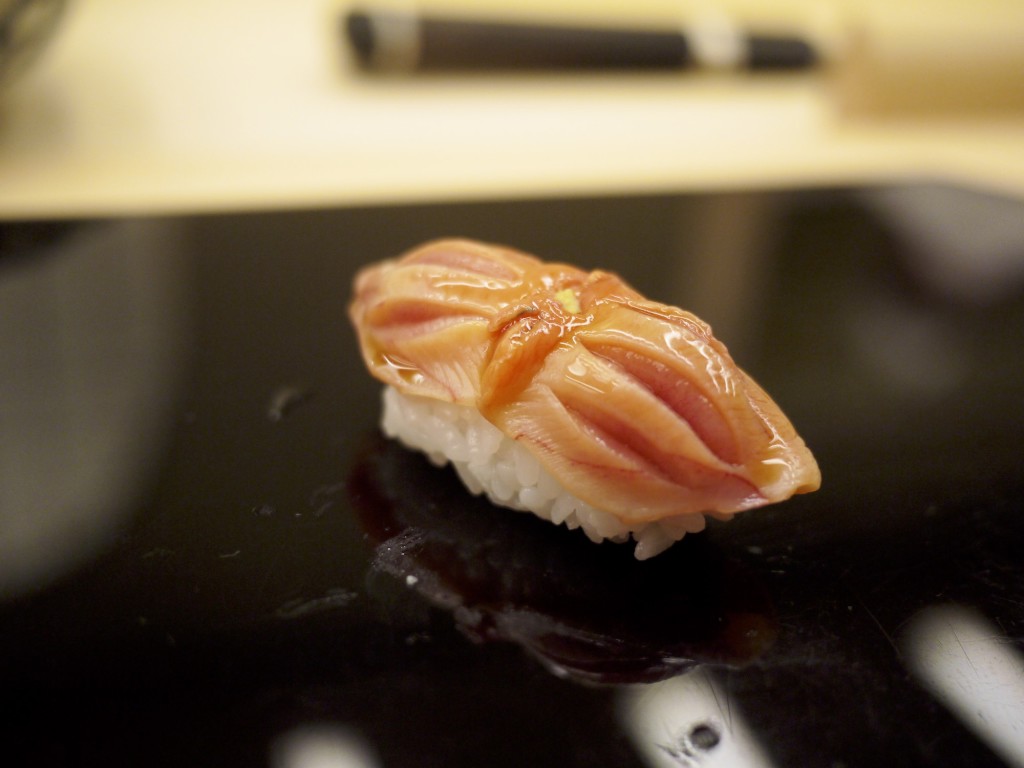 18th Course – Red clam / Akagai (赤貝). Again the quality of the superior red clam could be tasted here even before you ate the nigiri. The olfactory senses were teased before the tastebuds picked up the natural sweetness of the clam as soon as it landed on our tongue. Sensational.
18th Course – Red clam / Akagai (赤貝). Again the quality of the superior red clam could be tasted here even before you ate the nigiri. The olfactory senses were teased before the tastebuds picked up the natural sweetness of the clam as soon as it landed on our tongue. Sensational.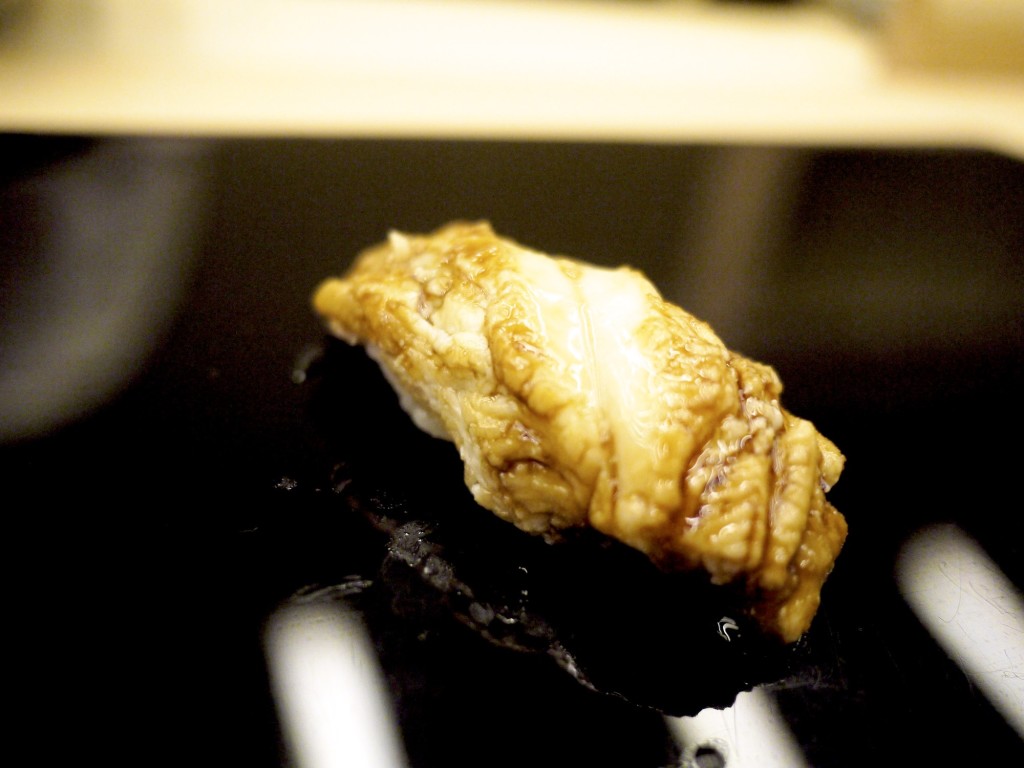 19th Course – Salt water eel / Anago (穴子). A lovely finale to our sushi segment which also brought a sense of disappointment that this was over all too quickly (mind you we were there for 2.5 hours). The eel was delicate in its soft texture, yet packed with enough flavour to balance well against the shari.
19th Course – Salt water eel / Anago (穴子). A lovely finale to our sushi segment which also brought a sense of disappointment that this was over all too quickly (mind you we were there for 2.5 hours). The eel was delicate in its soft texture, yet packed with enough flavour to balance well against the shari. 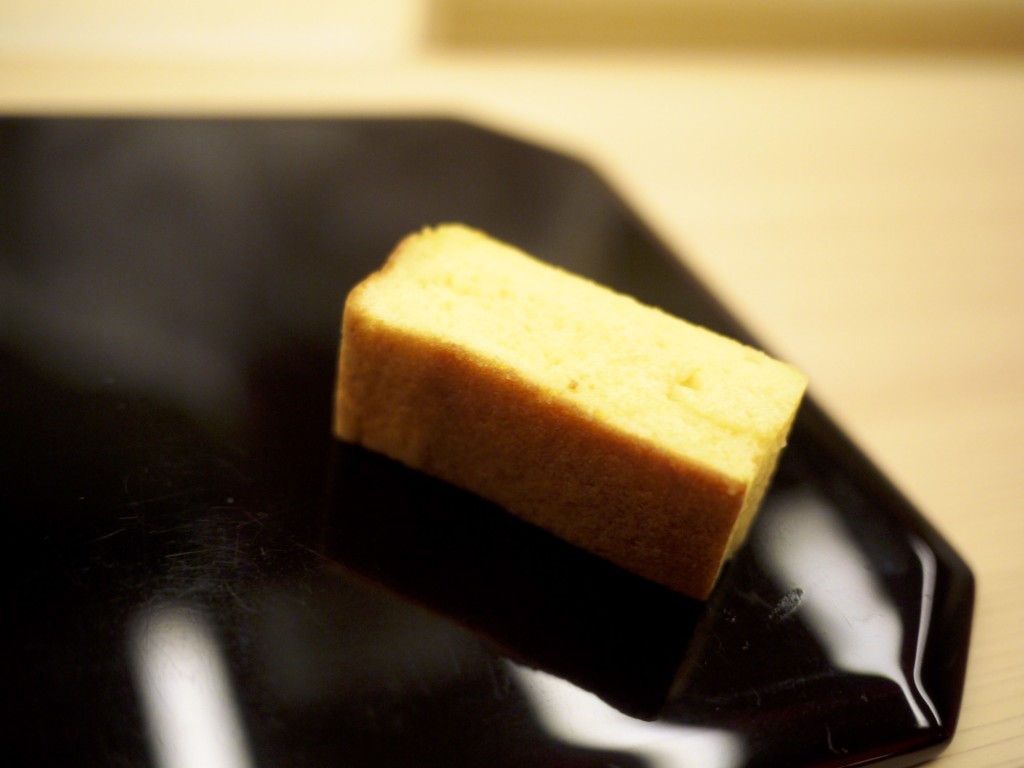 20th Course – Sweet egg omelette / Tamago (玉子). The omelette here was of the the finest quality one could get, utilising grey prawns (shiba ebi) and mountain potato (yamatoimo). It was very airy inside yet also had a firmness and held a lot of moisture. They say that one must have trained for over ten years before being able to serve an omelette at Sukiyabashi. You could certainly see the skill that went into making this tamago.
20th Course – Sweet egg omelette / Tamago (玉子). The omelette here was of the the finest quality one could get, utilising grey prawns (shiba ebi) and mountain potato (yamatoimo). It was very airy inside yet also had a firmness and held a lot of moisture. They say that one must have trained for over ten years before being able to serve an omelette at Sukiyabashi. You could certainly see the skill that went into making this tamago. 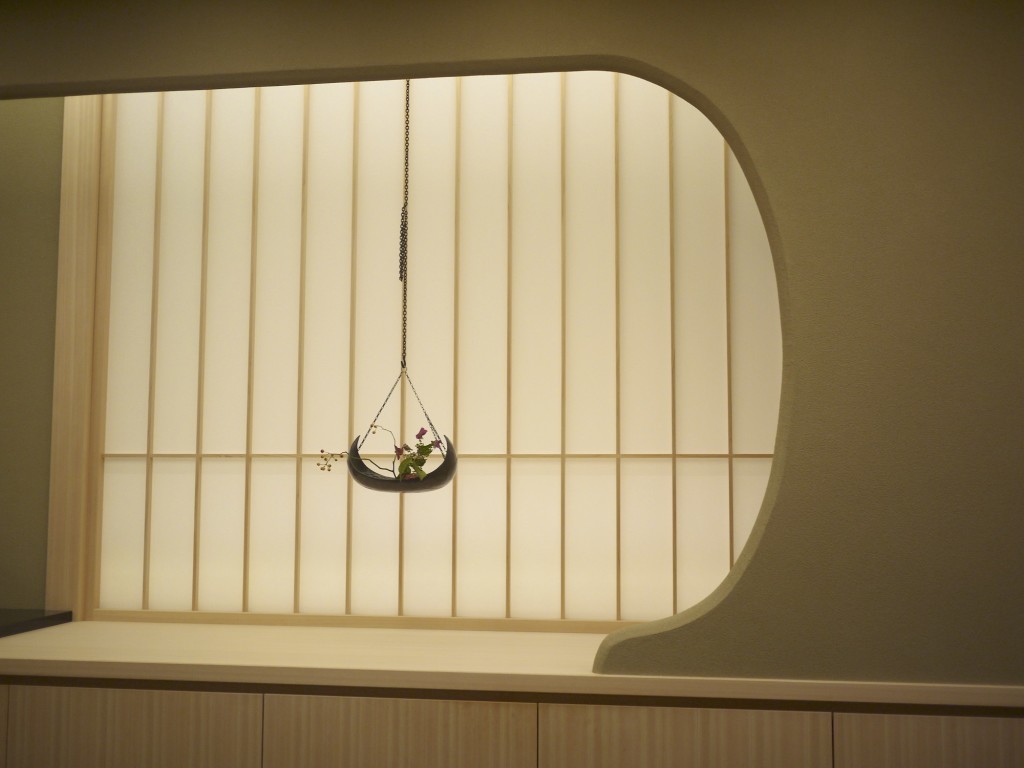 All in all the meal came to about 33,000 yen per person including the sake and a beer at the start which isn’t cheap yet certainly worth every yen when you consider the calibre of the food here. When I raised the question about the red book, the chef shrugged his shoulders as if he really couldn’t care too much. When you looked around the room you could see why. Every single diner here, other than us, appeared to be a regular and the chef knew each person’s likes and dislike. In an intimate environment like a proper sushi-ya, the regular custom is far more important than attracting new diners from afar. Whilst it makes getting reservations even more difficult for people living overseas like myself, I do hope this tradition does not disappear. It’s comforting to see that bond between a diner and a chef.
All in all the meal came to about 33,000 yen per person including the sake and a beer at the start which isn’t cheap yet certainly worth every yen when you consider the calibre of the food here. When I raised the question about the red book, the chef shrugged his shoulders as if he really couldn’t care too much. When you looked around the room you could see why. Every single diner here, other than us, appeared to be a regular and the chef knew each person’s likes and dislike. In an intimate environment like a proper sushi-ya, the regular custom is far more important than attracting new diners from afar. Whilst it makes getting reservations even more difficult for people living overseas like myself, I do hope this tradition does not disappear. It’s comforting to see that bond between a diner and a chef.
